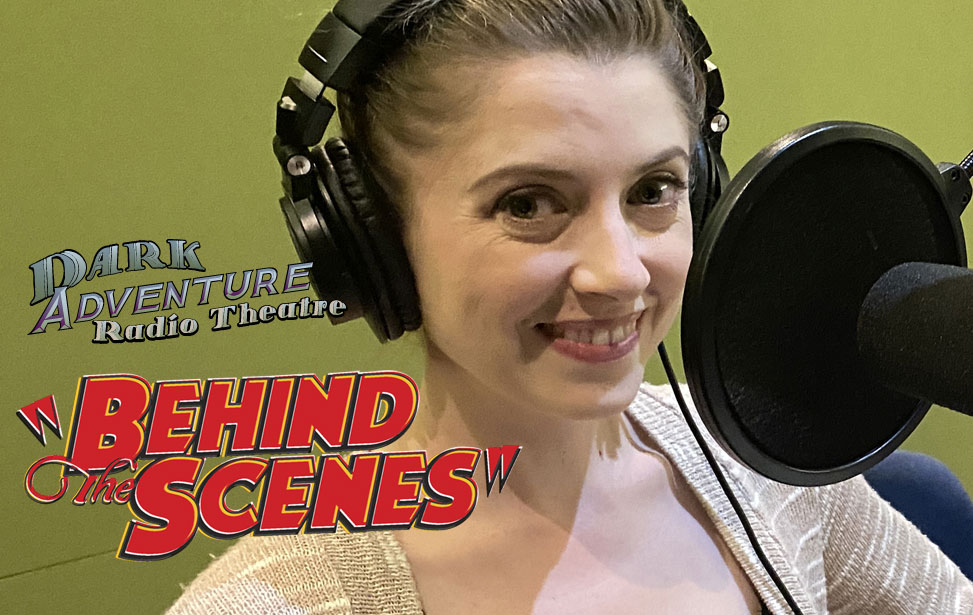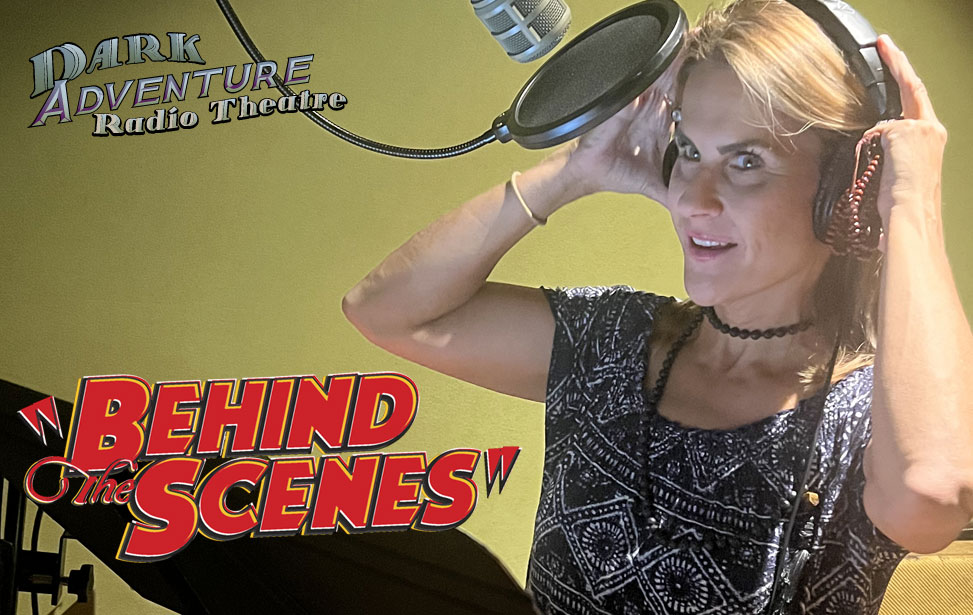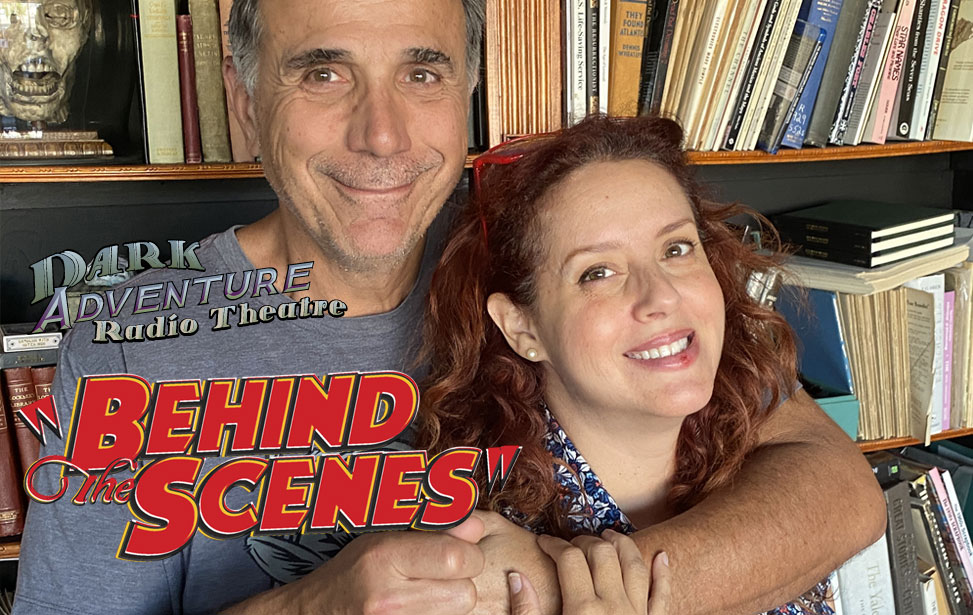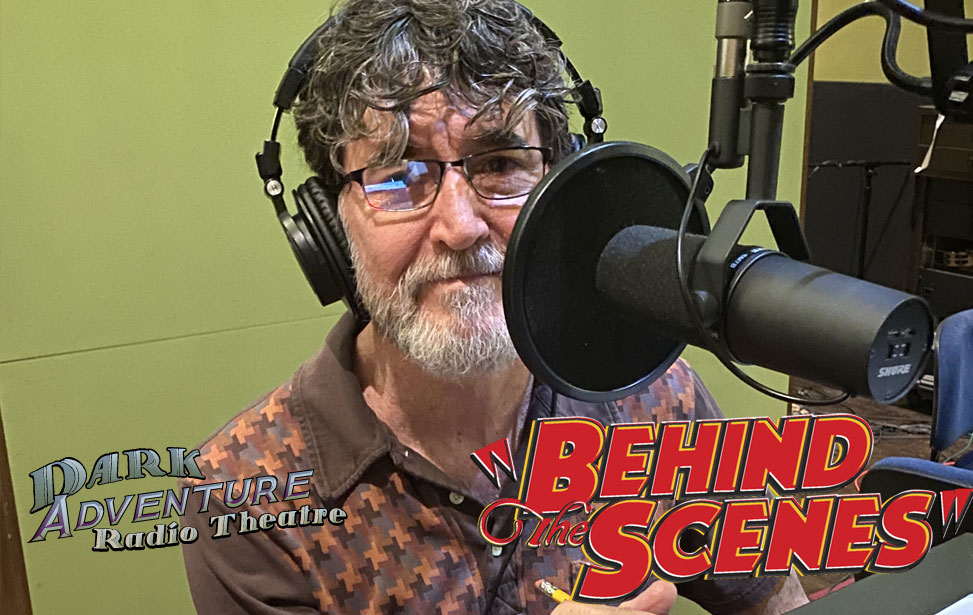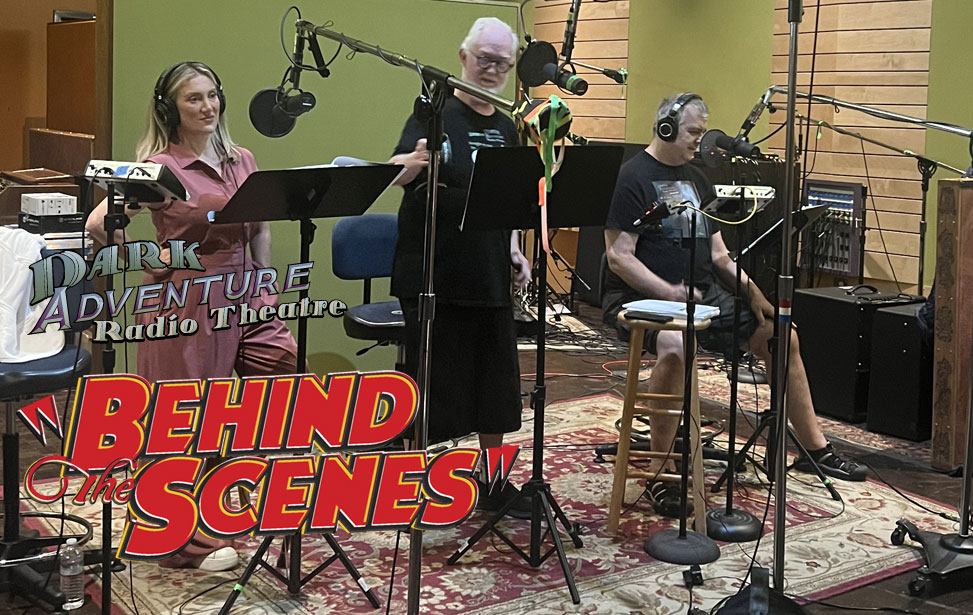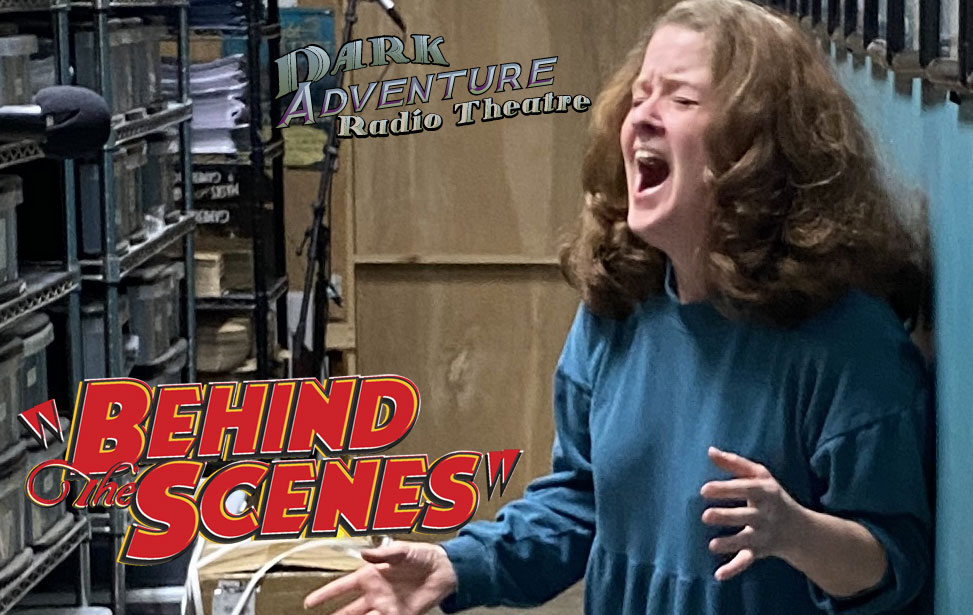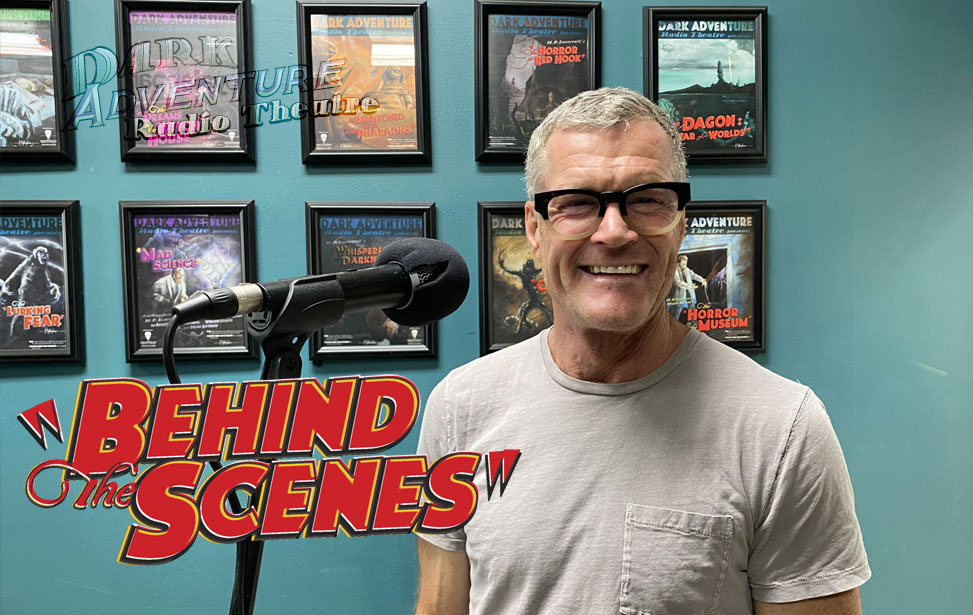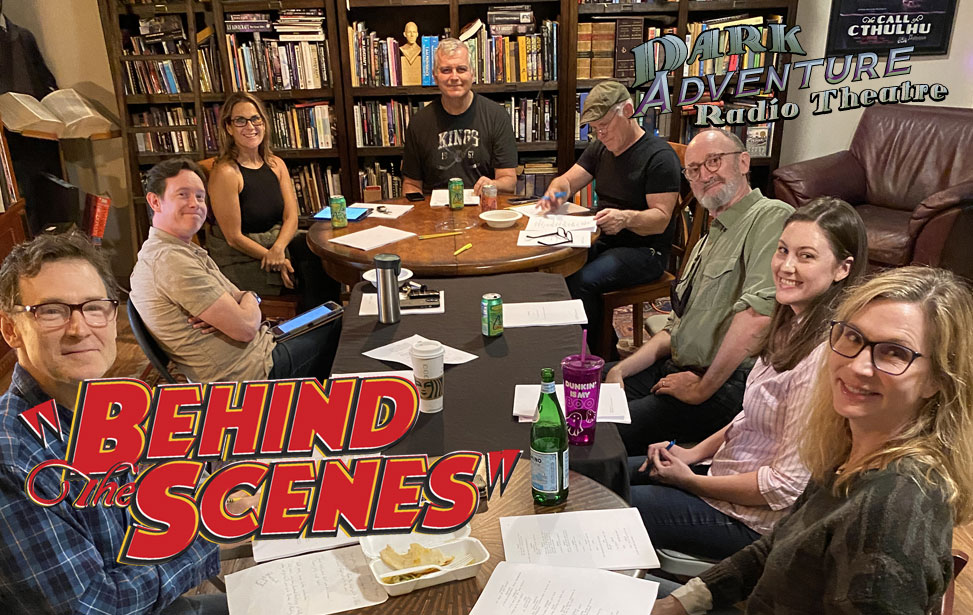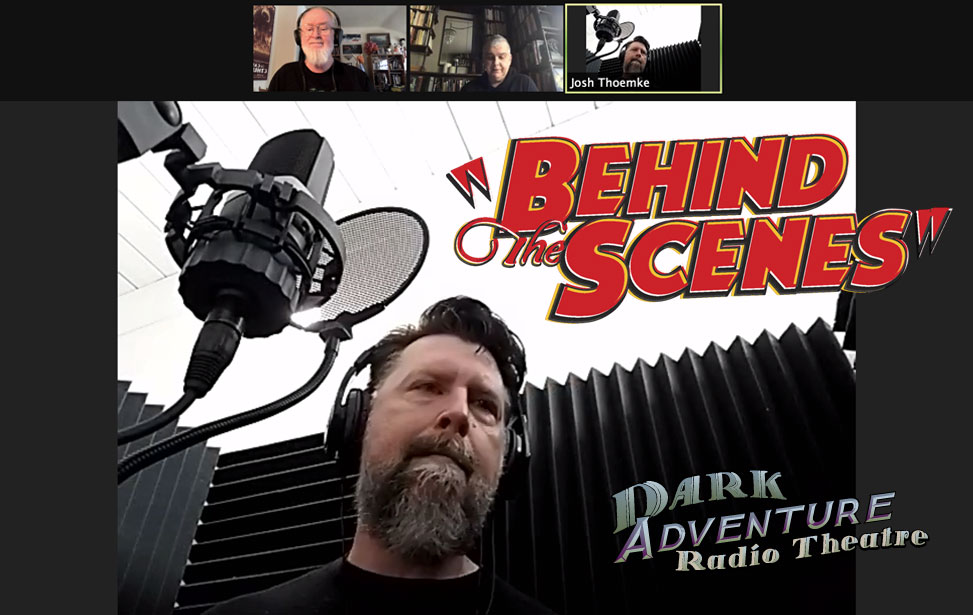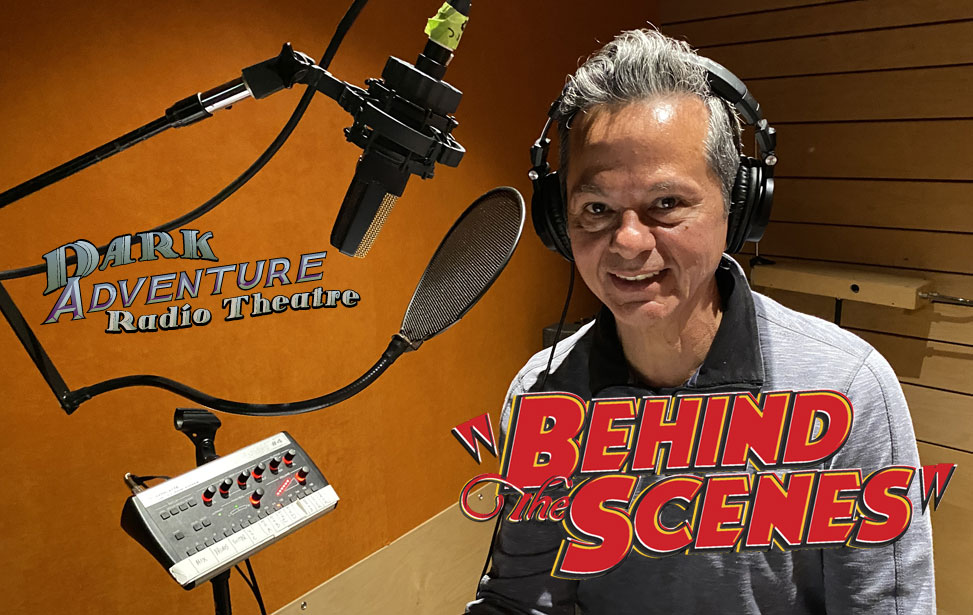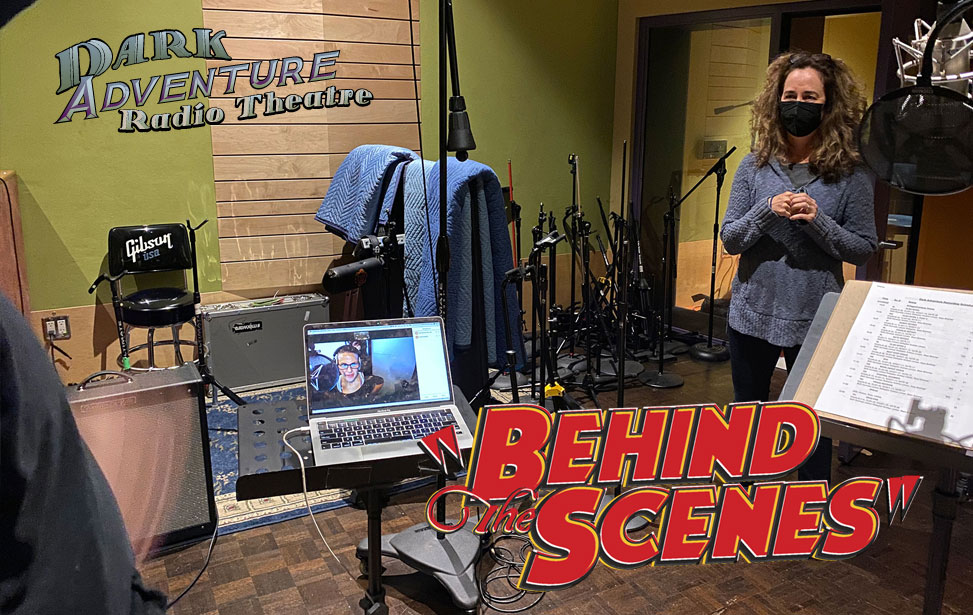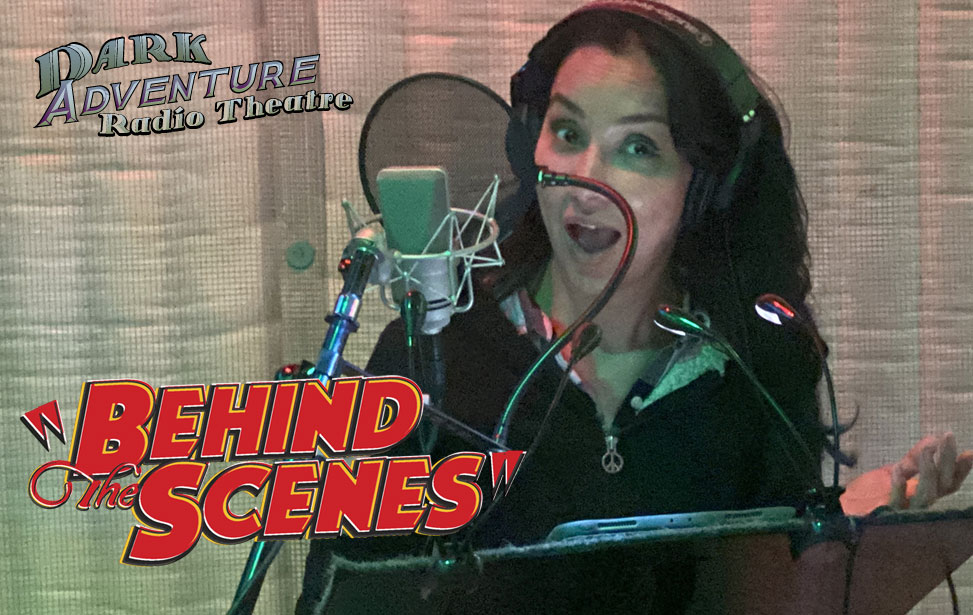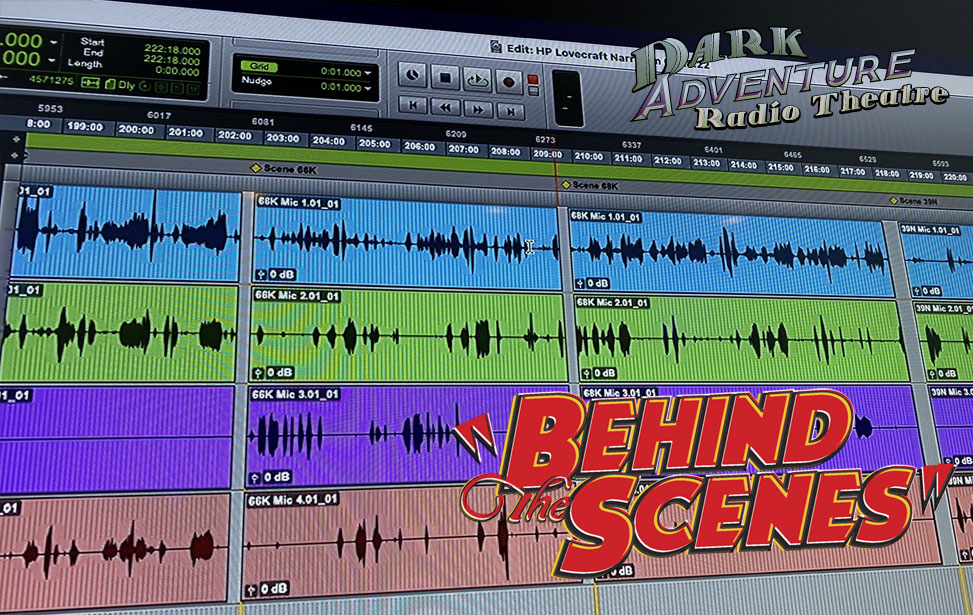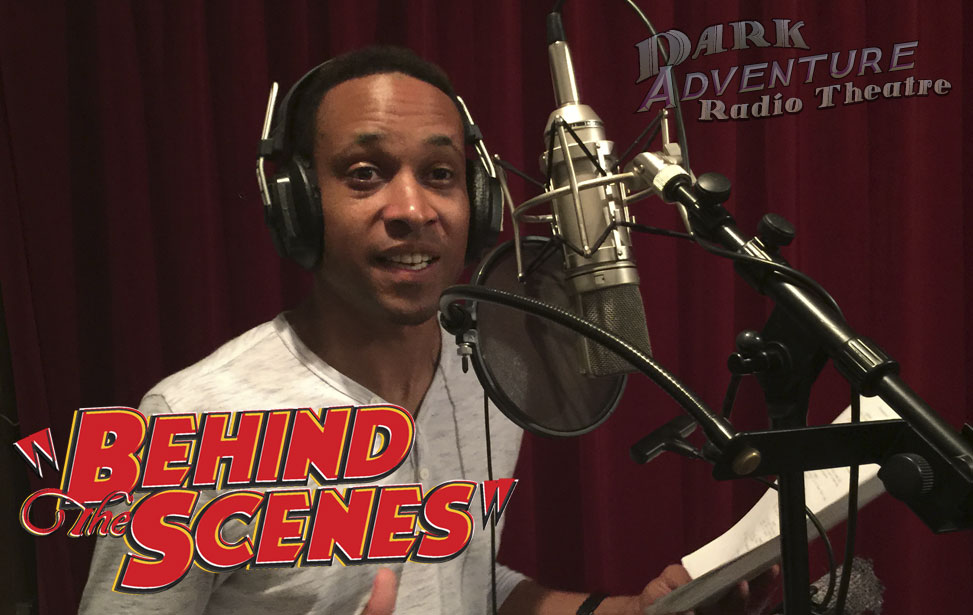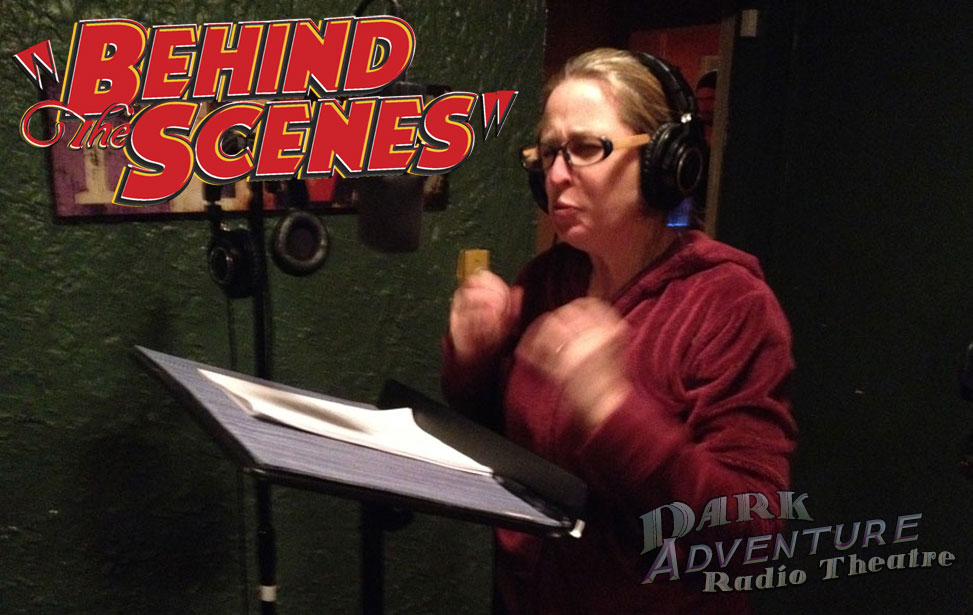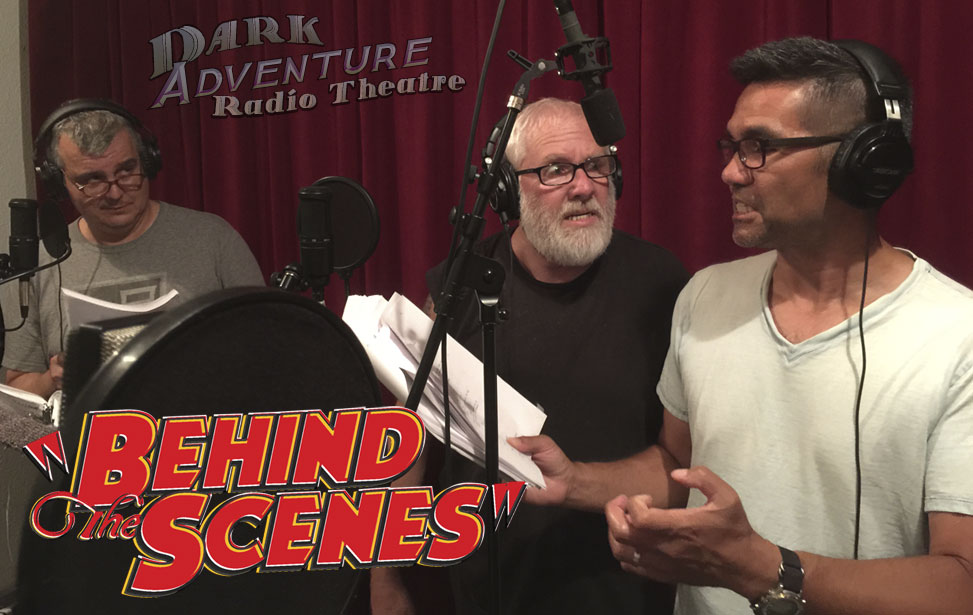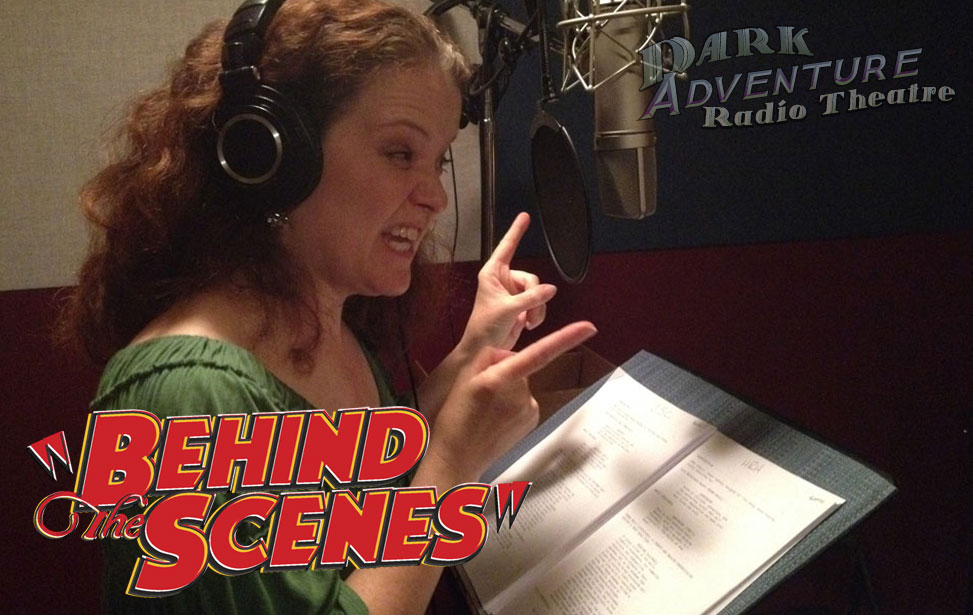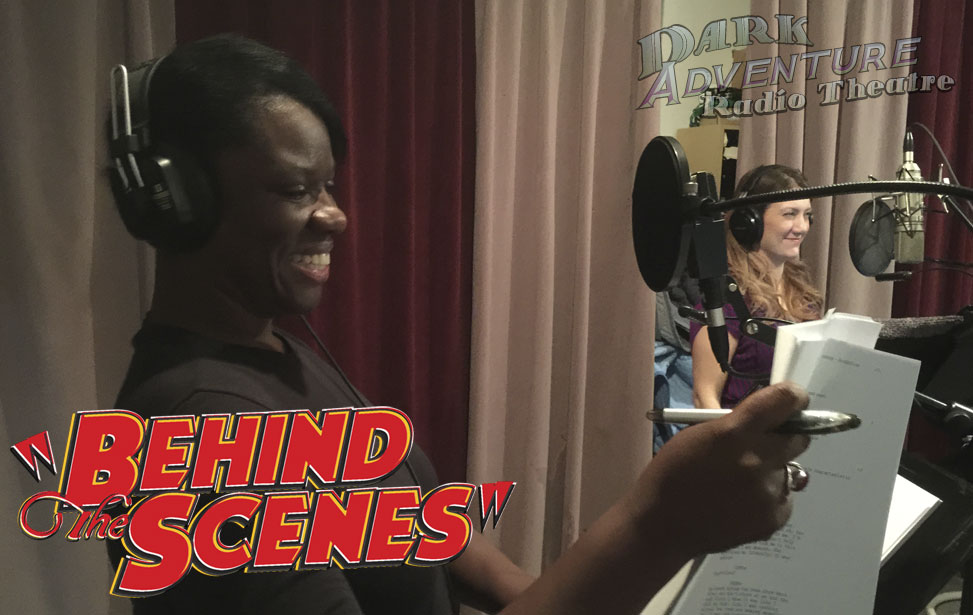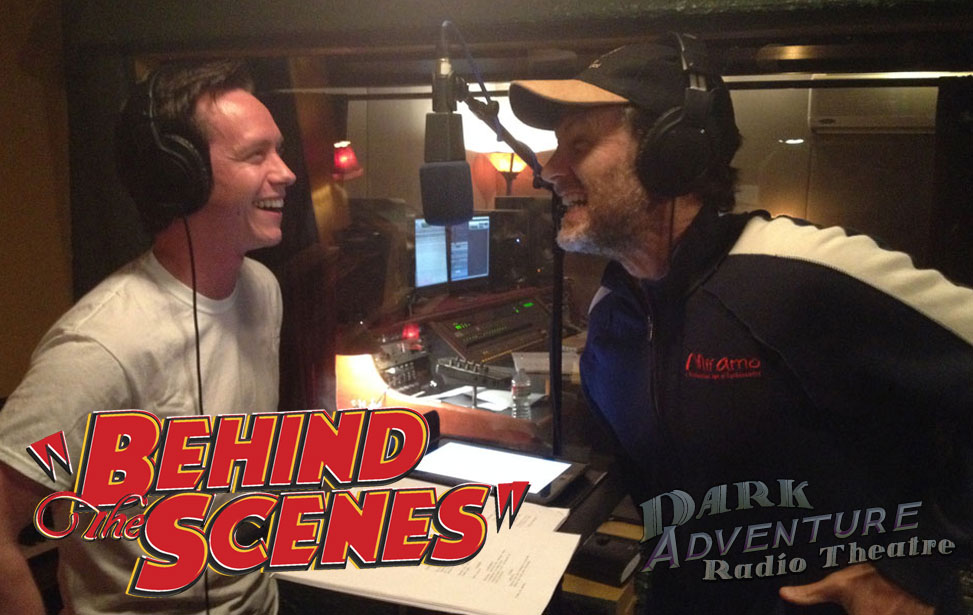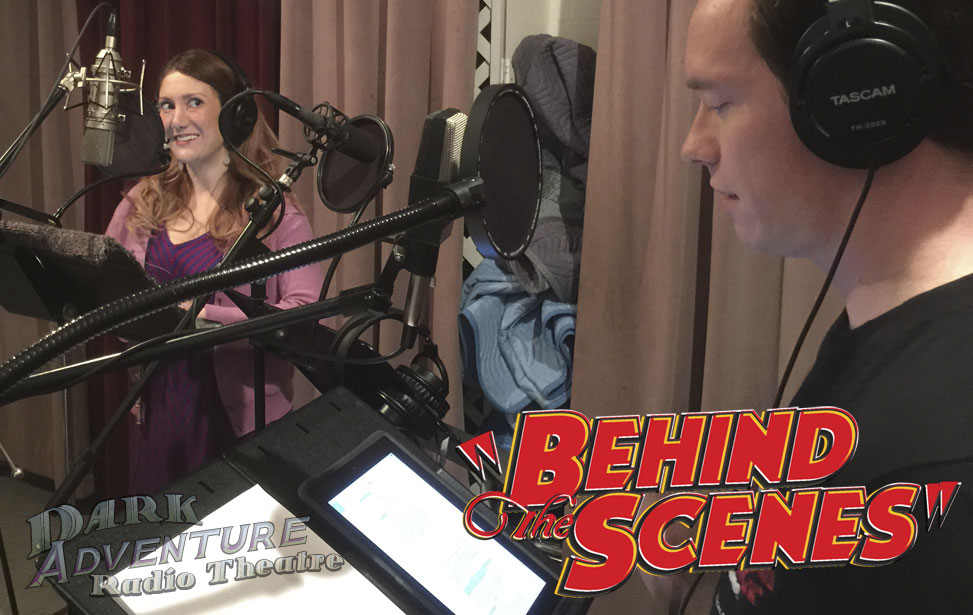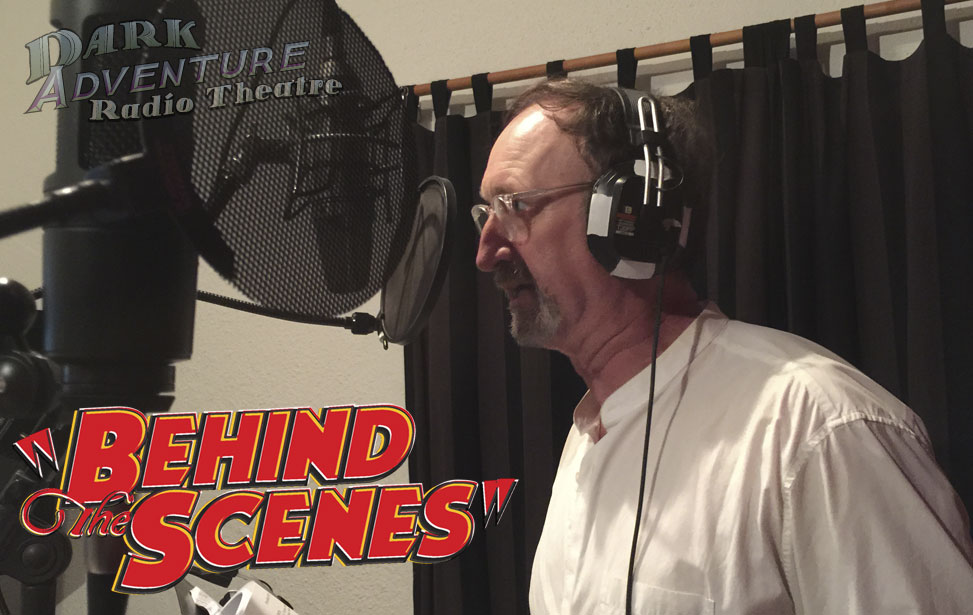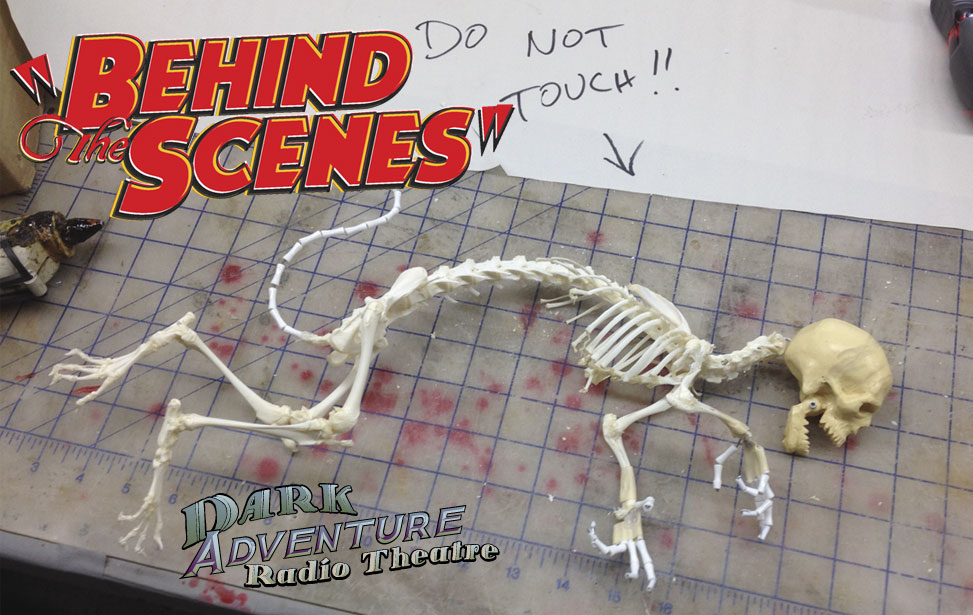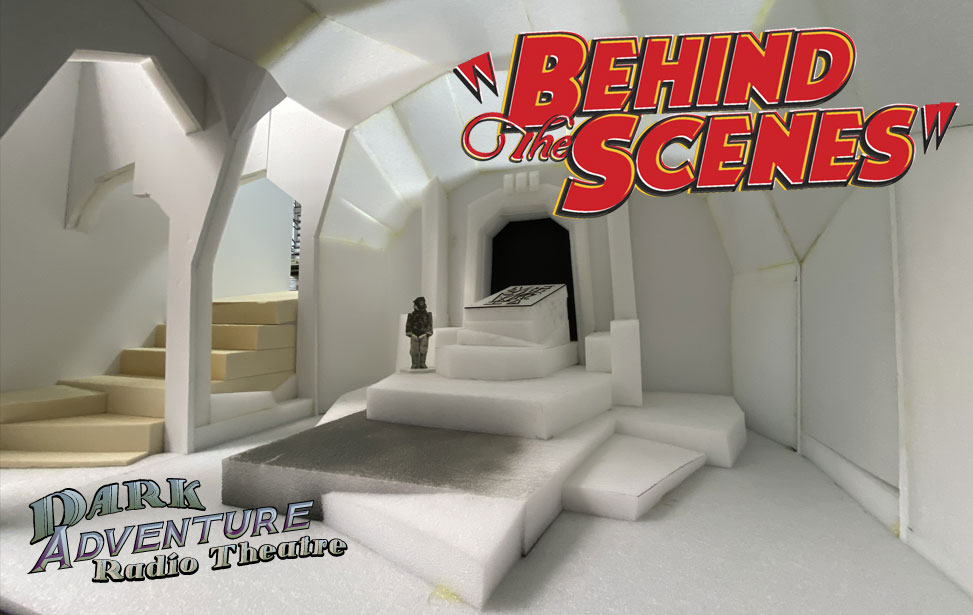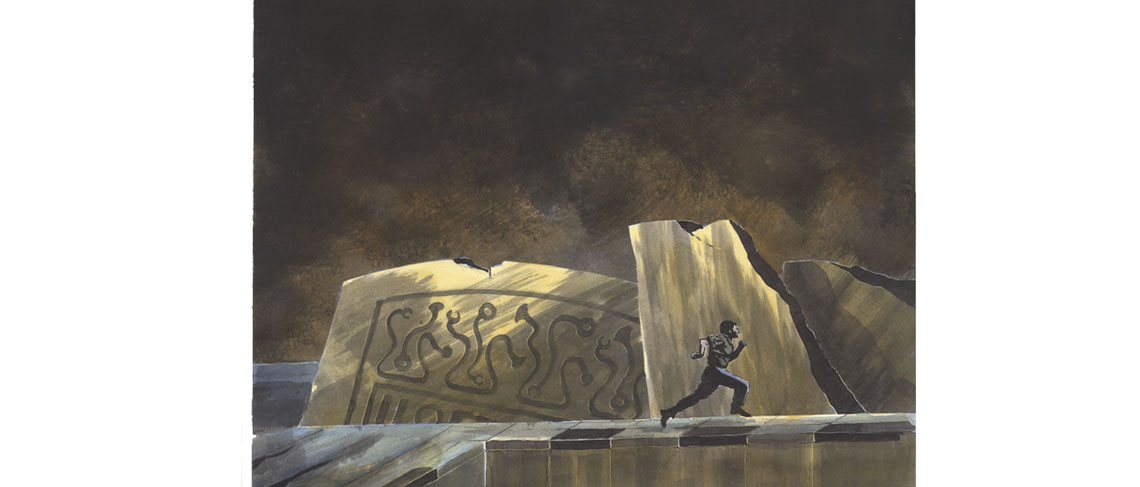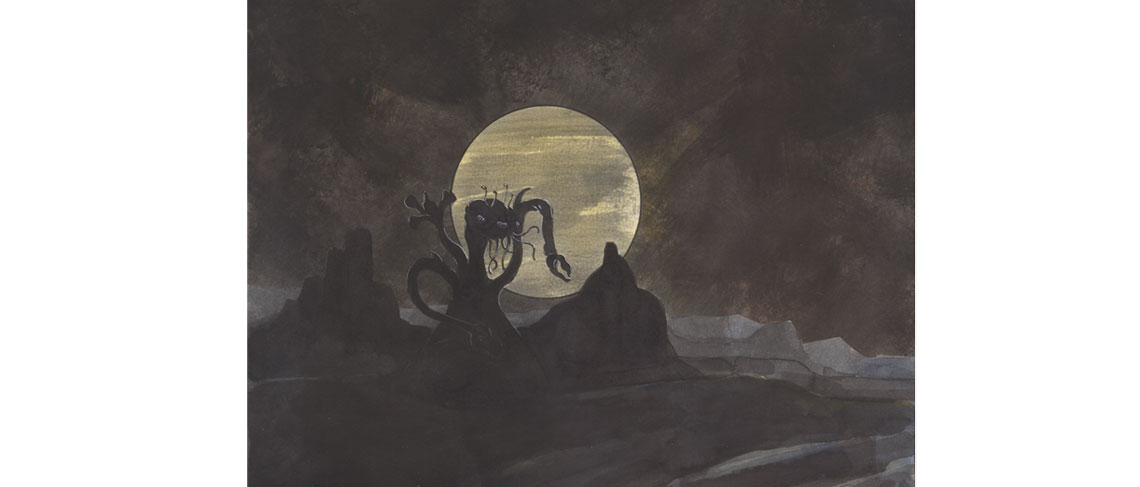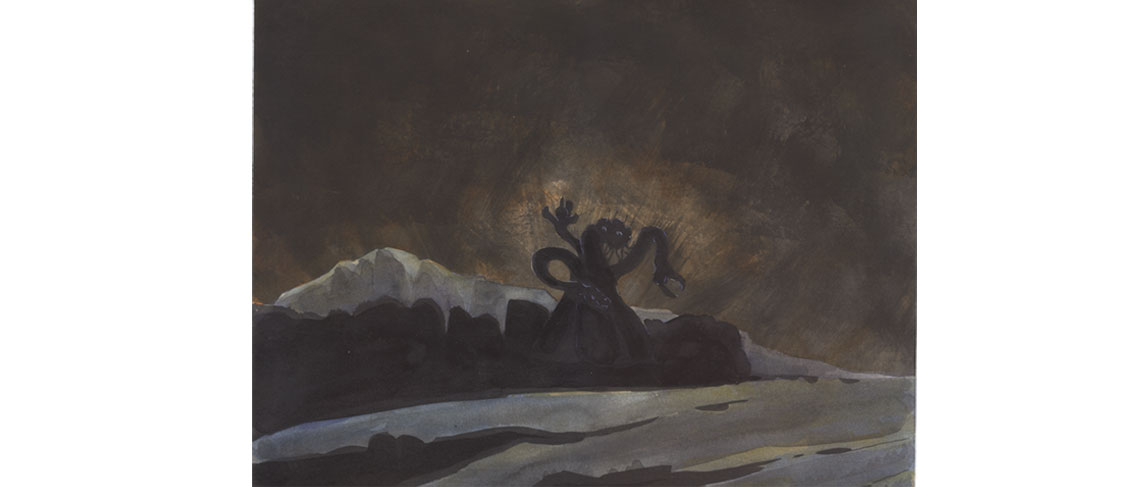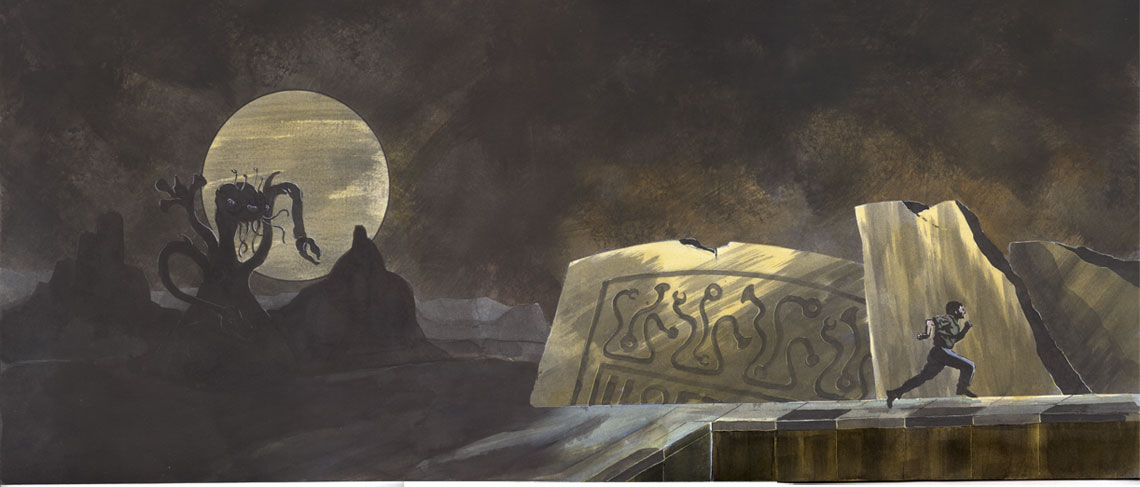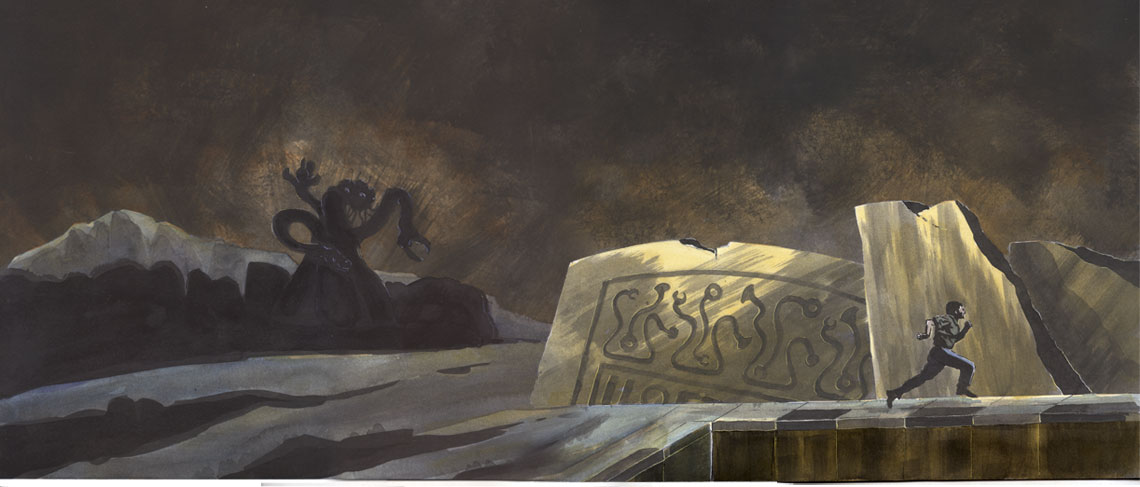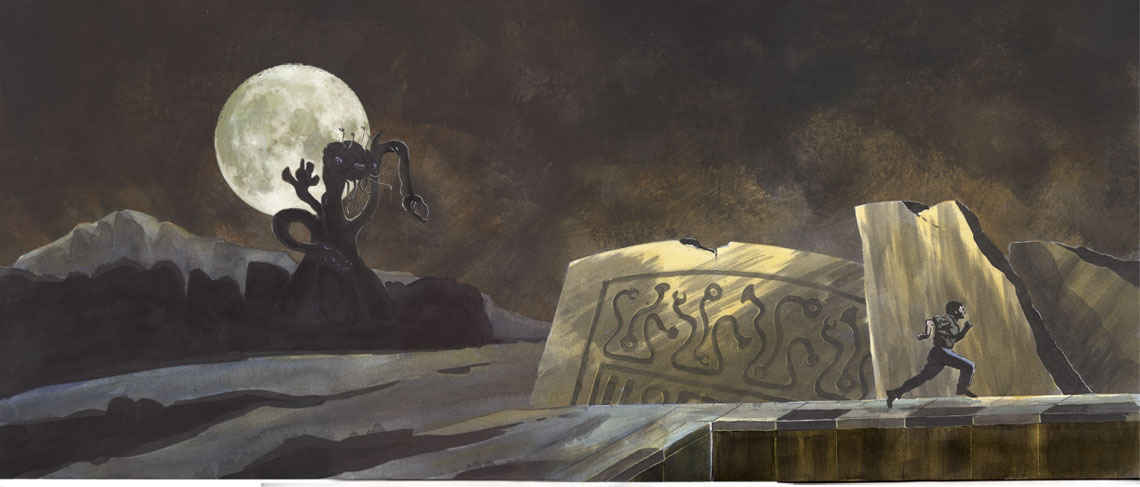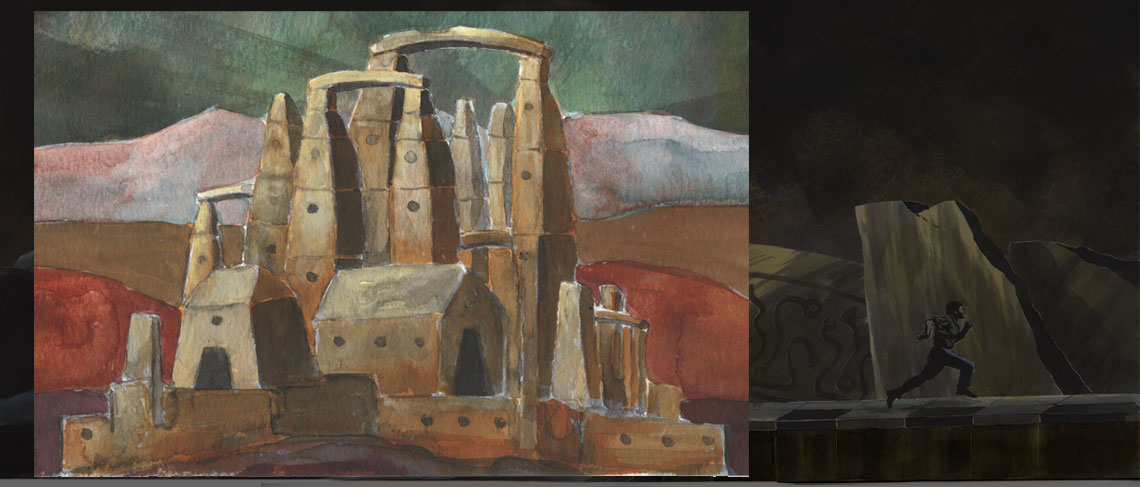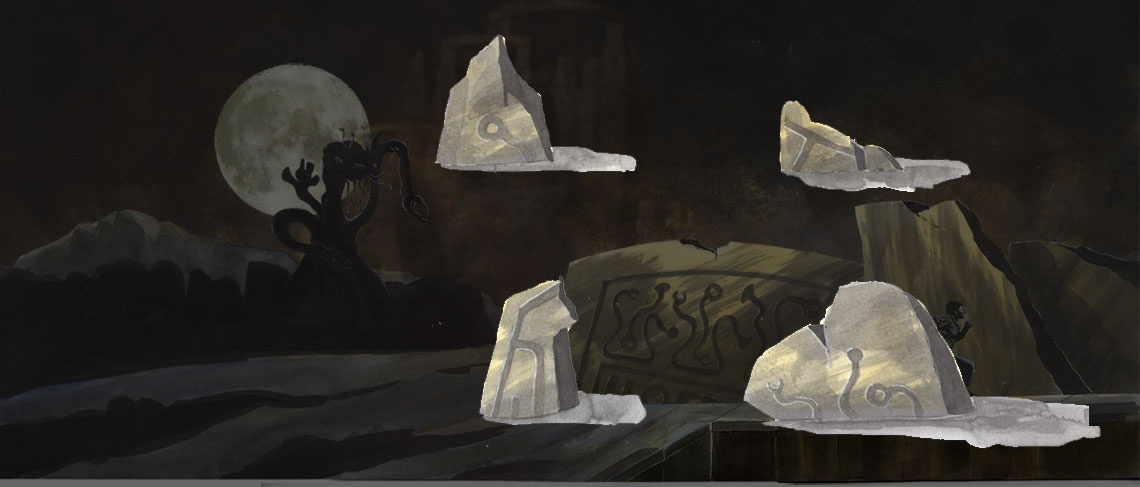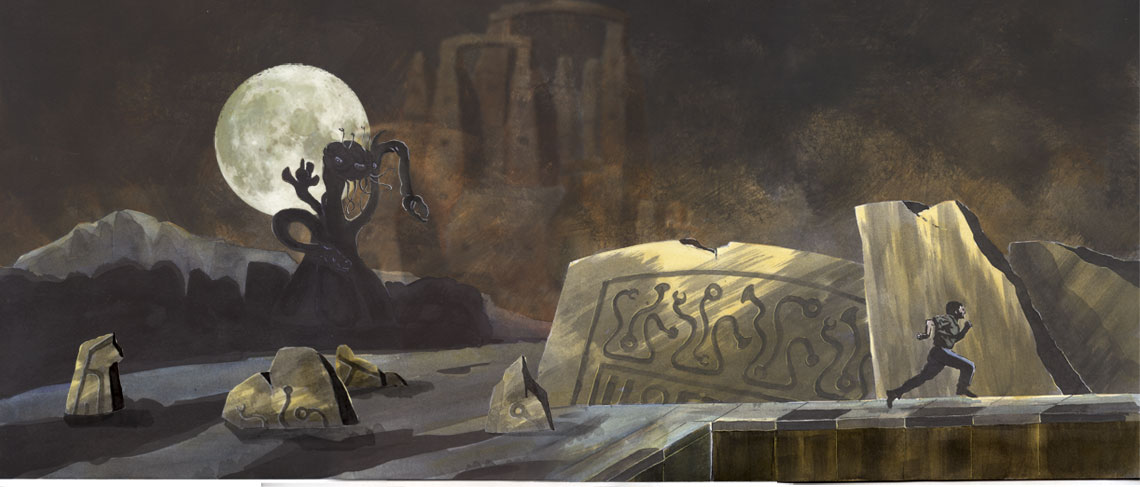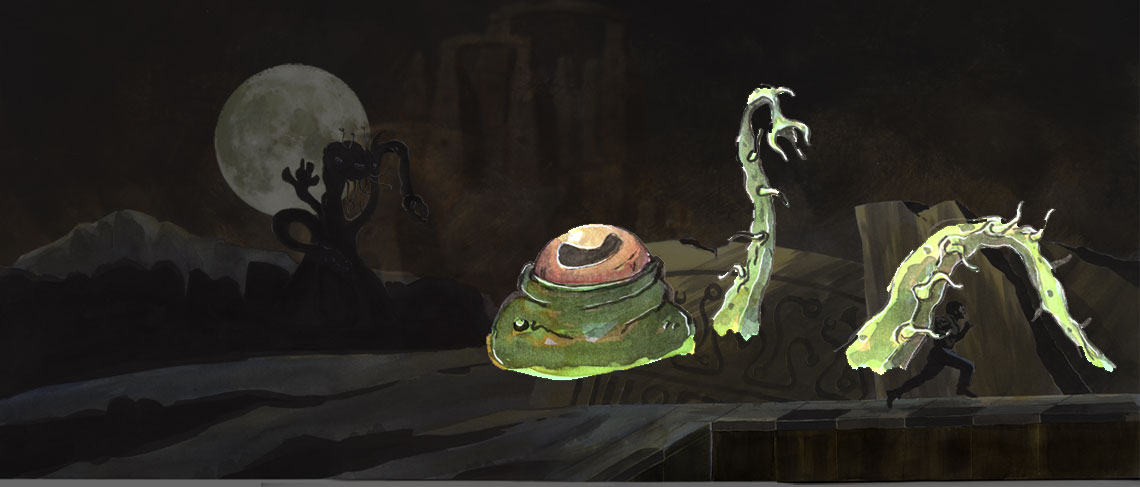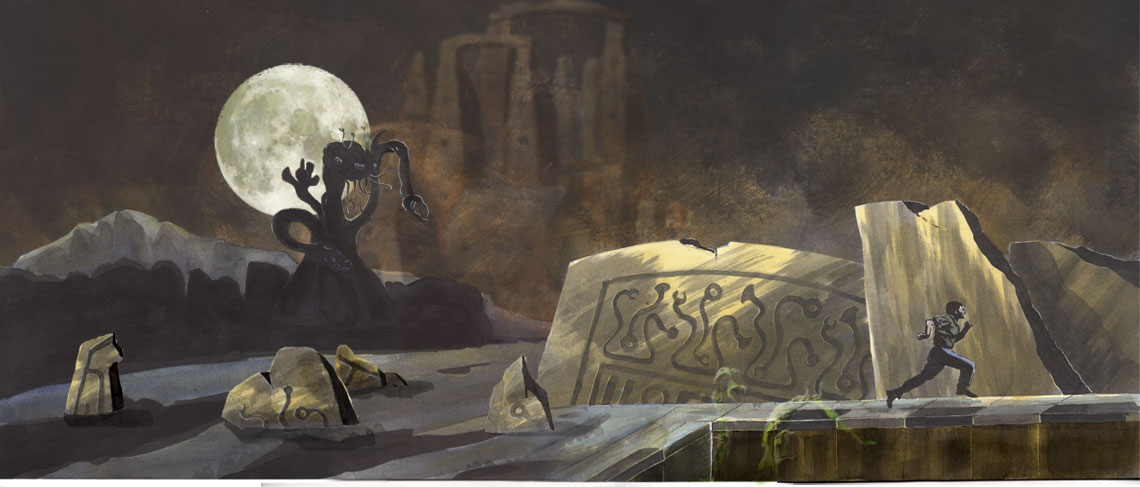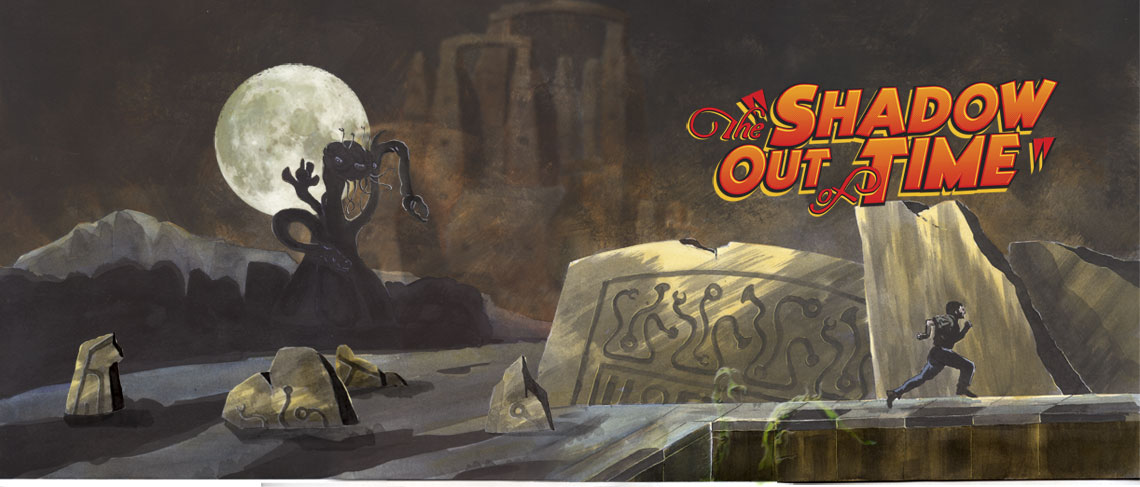Behind the Scenes
The videos here and the other contents on this page give a glimpse behind the scenes of the production of Dark Adventure Radio Theatre. Here you can see some of the faces behind the voices of Dark Adventure, and get a feel for the prep that goes into the performances. Our thanks go to sound engineer Chris Horvath, who worked on several episodes, for suggesting that we shoot some "making-of" footage. Below you'll learn about the talented musicians who score each episode, and get to hear some cues without all the drama laid over them. And you'll learn what indefatigable HPLHS illustrator Darrell Tutchton puts up with when he provides cover art.
A Radio Show with Props?
Dark Adventure Radio Theatre episodes can be enjoyed completely as a purely auditory experience, but the bonus prop items included with each CD take the entertainment to a new level. Props are magical items: as the physical relics of an imaginary experience, they exist in at least two dimensions simultaneously.
Including prop documents allows us to expand DART storytelling by adding new information, richer insight, historical and cultural context, and offering visual, tactile, and sometimes even olfactory sensations to stir the listener's imagination more deeply. When you hold in your hand the very newspaper clipping or diary page
or photograph that the characters in the show are talking about, you are transported into their world and become a part of the story itself. And the props can be the jumping-off point for listeners to create stories of their own. Perhaps you'll notice a detail in that page from the Necronomicon that the characters in the story overlooked....
Props Out of Time
Producing the prop documents can take quite a bit of work. Sometimes we even stage photographs by first building scenic miniatures to take pictures of, which makes them props within props. Every episode is different, but each one includes a newspaper clipping. For The Shadow Out of Time, for example, there is a clipping from the Arkham Advertiser with a story about Nathaniel Peaslee's first collapse: an iconic moment in Lovecraftian fiction. Like all our clippings, it is printed like a real newspaper on a web offset press. Peaslee writes numerous articles about his dreams which are published in medical journals, and such an article seemed like an excellent candidate for another prop document, since it would provide an opportunity to provide a picture of his nightmare city and Yithian writing. It's printed on glossy magazine paper. A vintage shore-to-ship telegram seemed like another good candidate, and the Marconigram we included is based on a real vintage Australian steamship company telegram. It is printed and die-cut on yellow paper, then each one is carefully folded by hand and sealed shut with a stamp. Finally, a page torn from an ancient occult tome: Von Unaussprechlichen Kulten, one of the many books that Peaslee consults when trying to figure out what happened to him during the period of his amnesia. After doing our research into what's known about that terrible book, we wrote the text for the page in English, and then handed it over to Peter Lang, a friend of the HPLHS who lives in Germany, for translation. Peter also consulted with us about the old-fashioned German blackletter typography needed to prepare the final prop, which is printed on a gray book paper with a laid finish, to feel as much as possible like the real thing. When the accursed page was finished, we then retranslated it back into English, badly, for the alternate English-language bonus versions of the prop that are available as website PDF downloads. For these bonus props, we needed to create a replica of the letterhead of the University of Uppsala as it looked in the 1930s. We turned to our many Scandinavian friends for help, and they came through with abundant research images. We'd like to thank David Munro, Björn Flink, Johan Forsberg, Peder Fredland Fuchs, Peter Möller, and Björn Lindström for all their assistance.
Cast & Crew
Dark Adventure Radio Theatre would be nothing without the talents of these incredible, accomplished people. Go visit their links and follow their exploits!
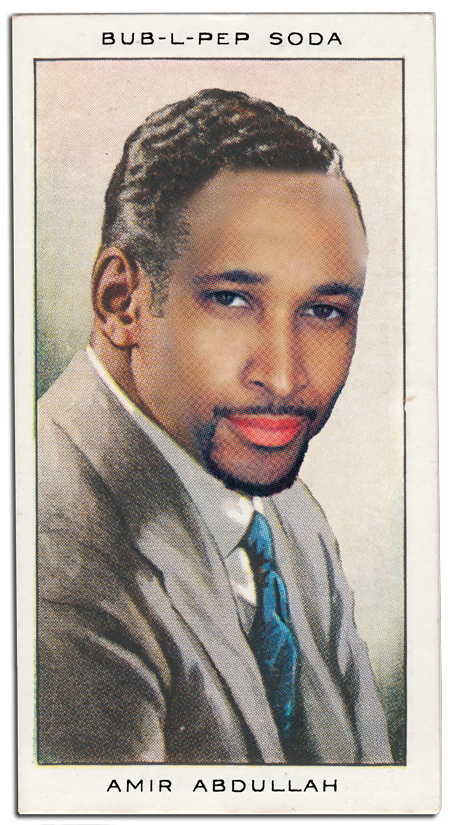 Amir Abdullah
Voice Actor
Amir Abdullah
Voice Actor
Amir is an award-winning actor, audiobook narrator of over 90 books, and writer. TV work includes Chicago Med, Empire, The Odd Couple,Tosh.0, and more. Films include The Untimely Concurrence (Movieville Int' FF - Best Actor) Radioflash, No Vows, No Cows and Booze Boys and Brownies. On stage, he has performed at The Geffen, Chicago Shakes, Writers Theatre, Indiana Rep, Milwaukee Rep, Court Theatre, Cal Shakes, A Noise Within, and other venues. His first full-length play, Pray To Ball, had its world premiere at Skylight Theatre. BFA – University of Miami; MFA – Penn State University.
BOB: Djemal Sidi
MON: (as Samir Shakur) Jackson Elias, Silas N'Kwane, Faraz Najjar, Johnstone Kenyatta
COY: Joe Compton
HIM: Orabona
TBS: Selim Bahadur
PC: K'moc-Hae
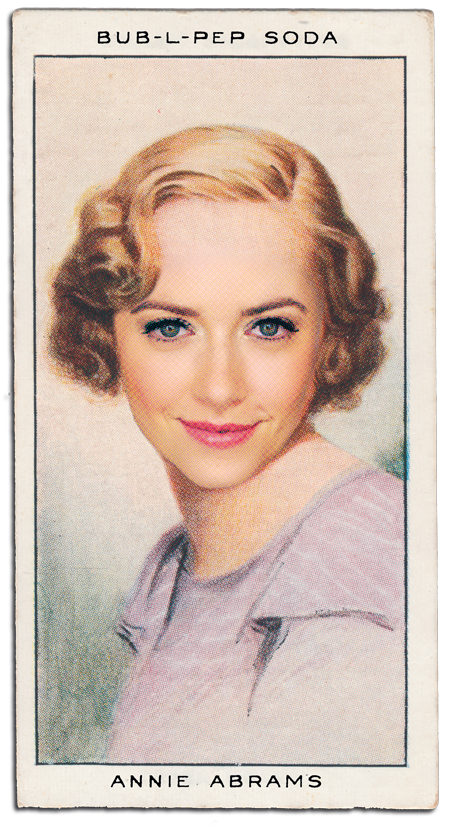 Annie Abrams
Voice Actor
Annie Abrams
Voice Actor
Annie is a Theatre Banshee veteran who adds her tremendous talent to the Dark Adventure team.
TSH: Martha, Ann White
TIM: Emily Dowdswell
BRS: Frankie Grimaldi
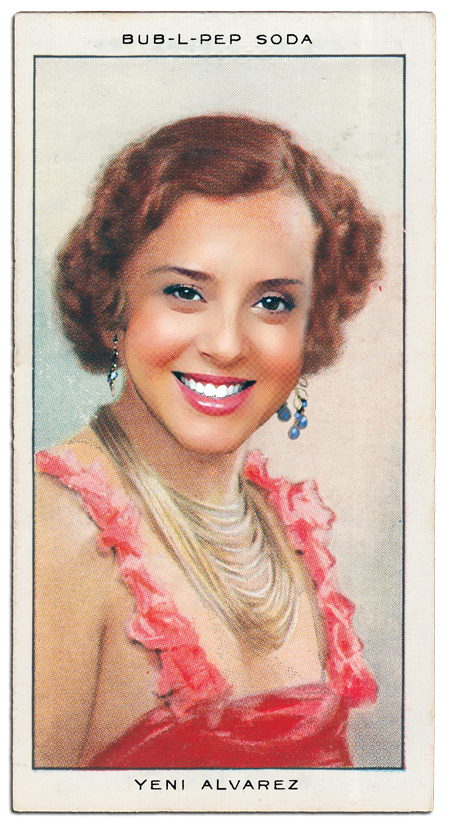 Yeni Alvarez
Voice Actor
Yeni Alvarez
Voice Actor
Yeni Alvarez is a dynamic actress whose career is defined by bold performances and industry firsts. She became the first Latina woman to voice a leading character in a video game, and the first true Latina character voice in Disney Parks, where millions hear her iconic safety narration every year and as the Tiki Room's Rosita. Before breaking barriers in voiceover, she starred in one of the highest-rated sitcoms in Spanish-language television, bringing razor-sharp comedic timing and emotional authenticity to the screen. Fluent in three languages, Yeni continues to carve out a trailblazing acting career fueled by craft, curiosity, and a love for storytelling in every dimension.
TJA: Letitia D'Ayala
TIM: Wedding Guest
BRS: Marilyn Knowles
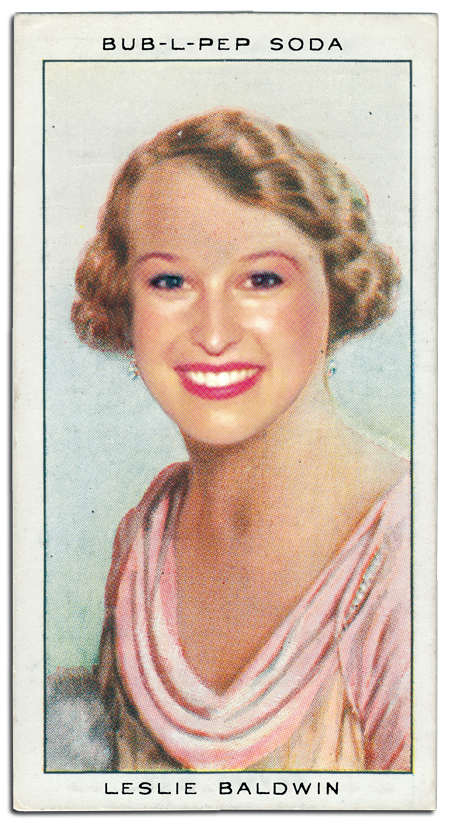 Leslie Baldwin
Voice Actor
Leslie Baldwin
Voice Actor
In addition to playing numerous roles in Dark Adventure Radio Theatre, Leslie appeared as Greta Johansen in the HPLHS motion picture The Call of Cthulhu. She is also an amazing cook who keeps the cast and crew indulgently well fed. She is a theatre producer in Los Angeles.
TDH: Marion Armitage, Mamie Bishop
SOOT: Alice Peaslee
COC: Greta Johansen
CDW: Mrs. Ward
COOS: Martha Pierce
IWP: Bess Houdini
HRH: Augusta Corlear
ASC: Aunt Lillian, Solstice Past
TWT: Flo
TOD: Shirley Upton
RIW: Mary Mulvany
TLF: Mrs. Bennett
MAS: Nurse Hunt, Juror #7
WID: Gladys Tantaquidgeon
COY: Maggie O'Toole, Sarah Mae
PC: Tla Munn
BRS: Myrna Muldoon
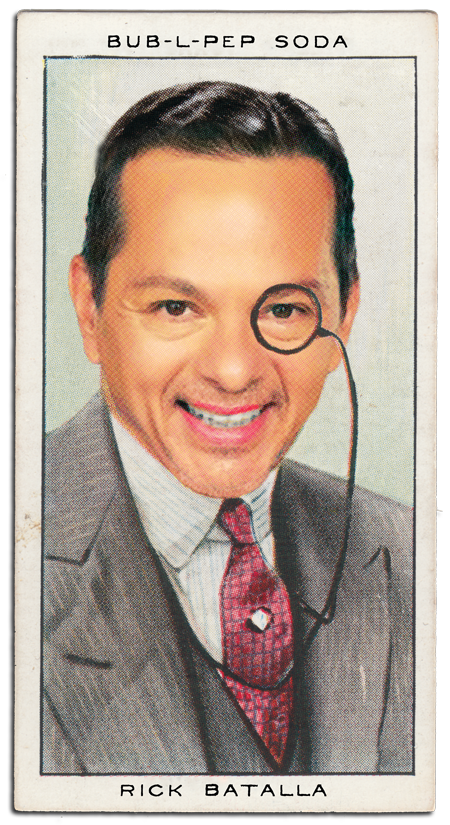 Rick Batalla
Voice Actor
Rick Batalla
Voice Actor
Rick is an award-winning performer, writer, and director for television, film and theater, and a founder of The Troubadour Theater company. Rick studied with the creator of The Groundlings in Los Angeles, and The Second City. He has been a series regular on shows like CBS’s Payne, ABC’s True Love and TBS’s Dinner and A Movie, where he also was the writer and director.
TBS: Farkas
TSH: Clifford Babbit
TJA: Bassel Saeed
PC: Guillermo, José Capablanca
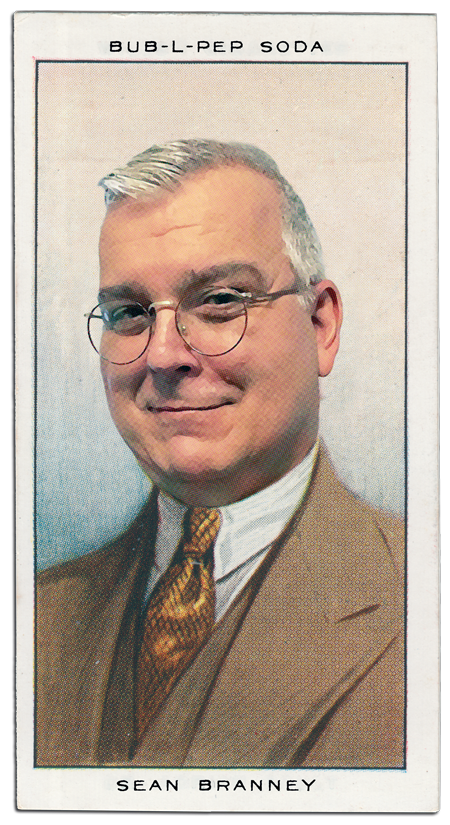 Sean Branney
Writer/Producer
Sean Branney
Writer/ProducerVoice Actor
Sean is a co-founder of the HPLHS and co-writes and produces every episode of Dark Adventure Radio Theatre. He also appears in every HPLHS motion picture. He is an accomplished and multi-award-winning theatre producer/director in Los Angeles.
ATMOM: William Dyer
TDH: Narrator
SOOT: William Dyer
SOI: Station Agent
COC: Castro
CDW: Capt. Whipple
COOS: Abel Cooke
HWR: Gordon Stuart
DWH: Frank Elwood
IWP: Harry Houdini
HRH: Det. Malone
DWOW: Nathaniel Ward
ASC: Barnaby Dickens
TWT: John Raymond Legrasse
TOD: Sergeant O'Donnell
BOB: Charlie Tower
HOD: Officer Monahan, Edwin Lillibridge
RIW: Matthew Delapore
FCMV: Dr. Michael Quinlan
BAM: Dr. Muñoz, Dr. Quinlan
MON: Zeke Ford, Mortimer Wycroft, et al.
TLF: Detective Croft
MAS: Joe Slater, Arthur Feldon, Dr. Muñoz, Postal Clerk
WID: Henry Akeley
COY: Big Jim Barrow
HIM: George Rodgers
TBS: Charlie Tower
TSH: Dr. Waite
TJA: Jim Whitman, Ph.D.
TIM: Lord Oglander
TPL: Altberg-Ehrenstein
PC: Charlie Tower
BRS: Al Neville
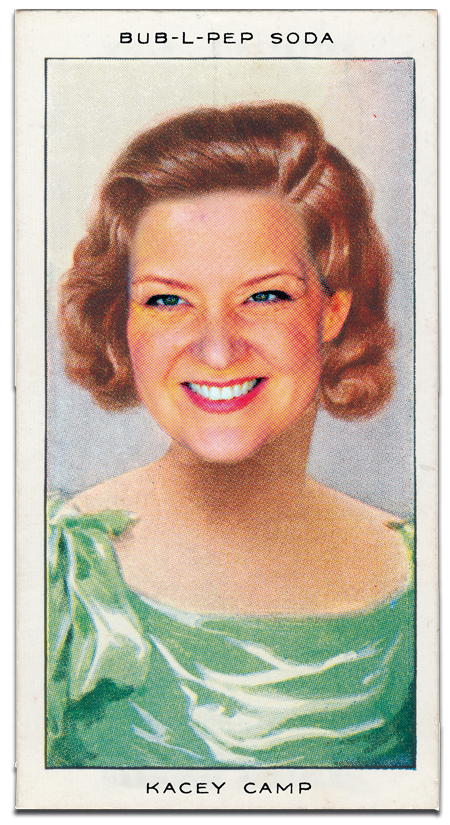 Kacey Camp
Voice Actor
Kacey Camp
Voice Actor
Kacey has been recording with Dark Adventure since 2008's "The Dunwich Horror". She has loved playing a wide variety of New England librarians, farmer's wives and precocious children (all doomed). Some of her favorite roles include Selina Frye, Anna Tipton, Nabby Gardner, Widow Huberdeau, A.D.A. Crenshaw, Mama Munnee and Victoria Woodhull.
TDH: Sally Sawyer
SOOT: Young Wingate
SOI: Anna Tilton
COOS: Abigail Gardner
HWR: Harriet Bacon
HRH: Old Woman
ASC: Aunt Annie
TWT: Cheryl Huberdeau
TOD: Madeline Crenshaw
BOB: Sarah Cornwallis
HOD: Lanigan Markham
RIW: Mildred, Lizzie Delapore
BAM: Mrs. Herrero, Miss Ruha, Mrs. Hegarty
MON: Victoria Woodhull
TLF: Mama Munnee, Billy
MAS: Dr. Louise Pearce
WID: Western Union Clerk
COY: Dawn Crow, Jenny Rigby, Jimmy Jack
TBS: Claudine Ladeau, Cult Victim
TSH: Nurse Paiva, Donovan, Mercy Dexter
TJA: Trixie
TIM: Lady Oglander
PC: Miskatonic Librarian, Huatze, Grumpy Slave, Plgh
BRS: Vivienne Wallace
 Reber Clark
Composer
Reber Clark
ComposerVoice Actor
Reber is a composer and filmmaker who has contributed to many Lovecraftian projects, including The Curious Sea Shanties of Innsmouth, Mass. and the H. P. Lovecraft Literary Podcast. Reber has also performed music and sound effects in several live performances of DART episodes in Portland and Providence.
CDW: Original music
HWR: Original music
DWOW: Original music
HOD: Original music
FCMV: Original music
BAM: Original music
MAS: Original music
COY: Original music
HIM: Original music
TIM: Original music
PC: Original music
BRS: Original music
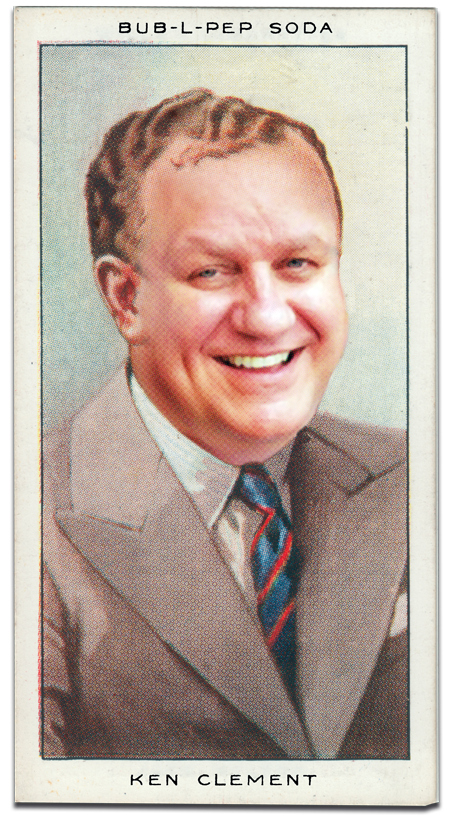 Ken Clement
Voice Actor
Ken Clement
Voice Actor
Ken is a Florida native and graduate of CalArts. He's appeared as 'that guy' in a whole bunch of movies and TV shows and most recently spent the last six winters touring the country as Santa in the National Tour of Elf the Musical
MON: Lester Mayhew, Jonah Kensington, Omar al Shakti
TLF: Lester Mayhew
MAS: Lester Mayhew, Dr. Brainerd, Juror #9
COY: Lester Mayhew
HIM: Lester Mayhew
TBS: Lester Mayhew
TSH: Lester Mayhew
TJA: Lester Mayhew
TIM: Lester Mayhew
TPL: Lester Mayhew
BRS: Lester Mayhew
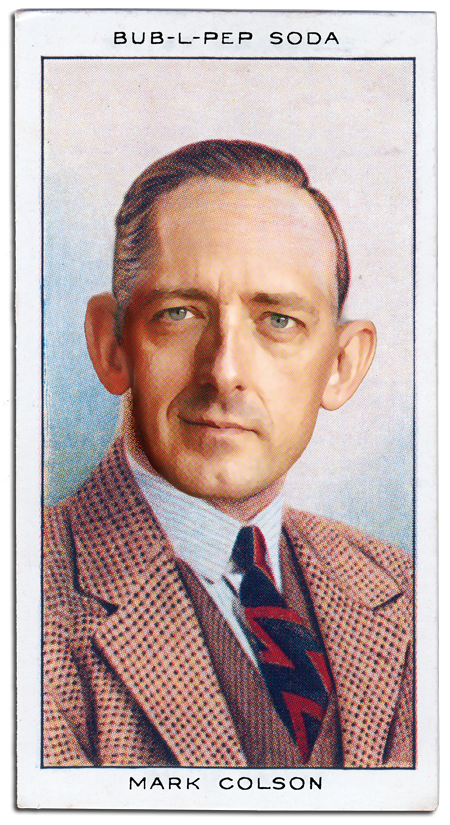 Mark Colson
Voice Actor
Mark Colson
Voice Actor
A veteran of stage and screen in Los Angeles, Mark is a professor of media at the University of Michigan.
TDH: Wilbur Whateley
SOOT: Dr. Chambers
SOI: Gilman House Clerk
COC: Inspector Legrasse
CDW: John Brown
COOS: Nahum Gardner
HWR: Phineas Bacon
BOB: Harris, Kline
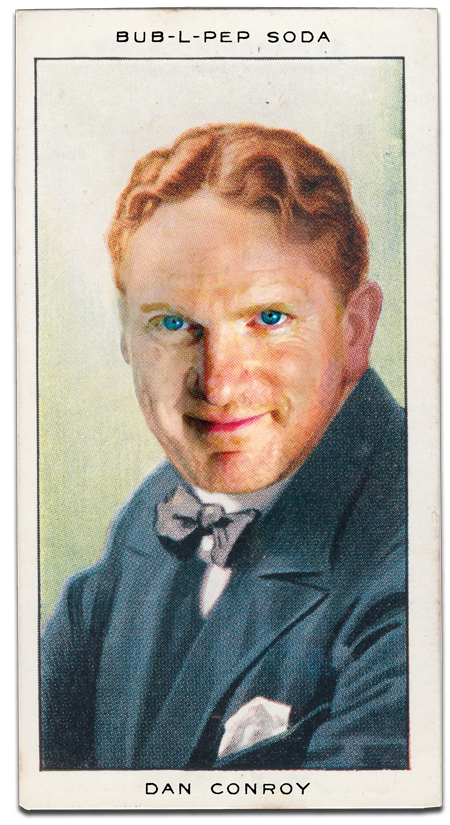 Dan Conroy
Voice Actor
Dan Conroy
Voice Actor
With his skill at dialects, Dan played multiple parts and served as Dark Adventure host Erskine Blackwell for eight episodes of DART. A very talented singer, Dan also appears in An Even Scarier Solstice and The Curious Sea Shanties of Innsmouth, Mass.
SOOT: MacKenzie
SOI: Agent McGraw
COC: Parker/Thibidoux
CDW: Ezra Weeden
COOS: Marsh/Humburg/Needham
HWR: Kid O'Brien
DWH: Polish Neighbor/Dean Bell
IWP: Pyramid Climber
RIW: Sgt. Hill, Wakefield
MON: Dr. Mundt, Dr. Starret, MacKenzie
TBS: Captain Kóvacs
TPL: Captain Pringle
BRS: Cantankerous Client, Robert Davidson, Nicky Bompensiero
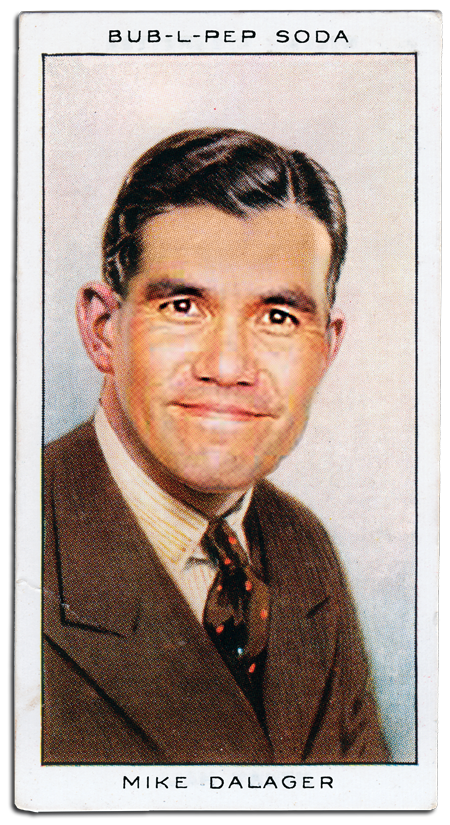 Mike Dalager
Voice Actor
Mike Dalager
Voice Actor
Mike first worked with the HPLHS in the motion picture of The Call of Cthulhu, then served a term as the HPLHS Shipping Shoggoth. He is the producer and star of Dreams in the Witch House: A Lovecraftian Rock Opera. He lends his amazing voice to An Even Scarier Solstice and The Curious Sea Shanties of Innsmouth, Mass., As a reservist in the U.S. Coast Guard, he occasionally sings the national anthem before major league baseball games.
COC: Galvez/Guerrera
CDW: Eleazer Smith
DWH: Brown Jenkin
IWP: High Priest, et al.
DWOW: Mare Island/Alcatraz/Hobbs
ASC: Curtis
BOB: Ucumari, Lazlo
MON: Murderous Cultist, Museum Guard, Old Bundari
COY: Grey Eagle
TBS: Border Guard, Wolf Priest
TPL: Salinger, British Sailor, American Sailor
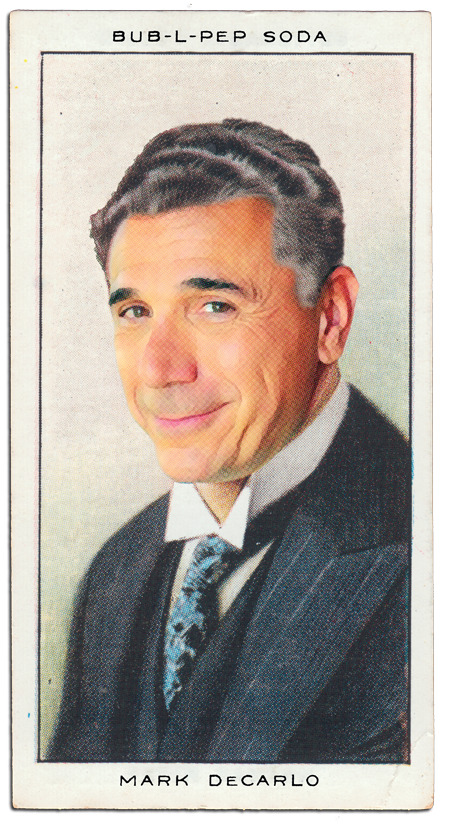 Mark DeCarlo
Voice Actor
Mark DeCarlo
Voice Actor
Mark DeCarlo is a comedian, author, travel & foodie expert and TV host. Mark won three consecutive Emmy Awards for his comedy segments on ABC's Windy City LIVE. Mark hosted the hit Travel Channel series "Taste of America with Mark DeCarlo" from 2004-2009, which spawned a comedic travel guide, "A Fork on the Road: 400 Cities, 1 Stomach." The bestseller was on the Amazon Top 20 for 19 consecutive weeks. Mark hosts and produces "A Fork on the Road Show" (2013- ), a leading travel/foodie podcast on the web, and writes a popular Travel Blog for Huffington Post, reaching over 1 million fans each week. Mark voiced the daffy patriarch Hugh Neutron in the Academy Award Nominated feature "Jimmy Neutron, Boy Genius," as well as the popular Nickelodeon TV series. He has been credited in several Dark Adventure episodes under the name "Dick Lizzardo".
MON: Nigel Wassif, Hakim, Fergus Chum
TLF: Gawker, Moe Pearce, George Bennett
WID: Nelson Barr
HIM: Ostman
TJA: Matteo Sportari
TIM: Wedding Guest
BRS: Landis King
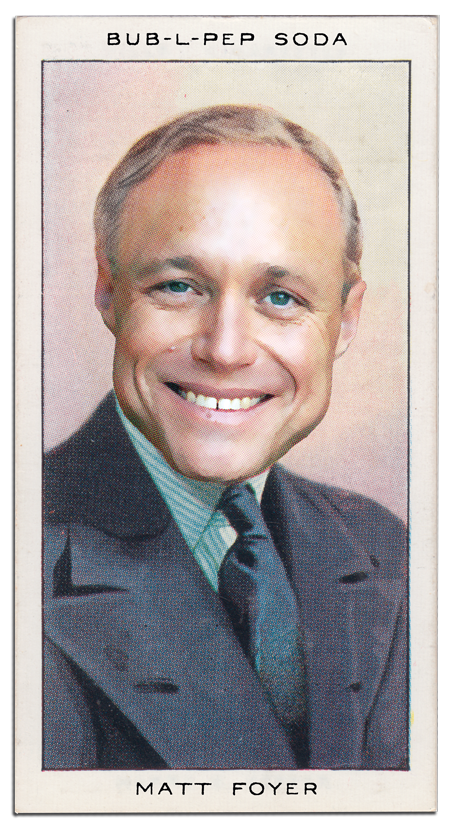 Matt Foyer
Voice Actor
Matt Foyer
Voice Actor
Leading man Matt starred in two HPLHS motion pictures, The Call of Cthulhu and The Whisperer in Darkness. A talented and multi-instrumental musician, he also sings on An Even Scarier Solstice and The Curious Sea Shanties of Innsmouth, Mass.
ATMOM: Atticus Lake
SOOT: Tyler Freeborn
SOI: Robert Olmstead
COC: Det. Mallory
CDW: Fenner, et al.
IWP: Dupuis, Pavao
HRH: Morgan
DWOW: Robert Olmstead
ASC: Reid
BOB: Rekemeyer, Cosgrove
HOD: Enoch Bowen, Sgt. Kelly
FCMV/BAM: Ernest M. Valdemar
MON: Albert Wilmarth, Ali Kafour, Dr. Huston
TLF: William Tobey, Johnathan Gifford
MAS: Hugo, Theodore Waite
HIM: Humphrey, Detective Inspector Brunk
TSH: Detective Brennan, Eleazar Durfee, Goodman Loucks
TJA: Max
TIM: Chalvers, Evans, George
TPL: Padre Morgado, Talbot, Bohm
PC: Neal, Goodman Thorpe
BRS: Fritz
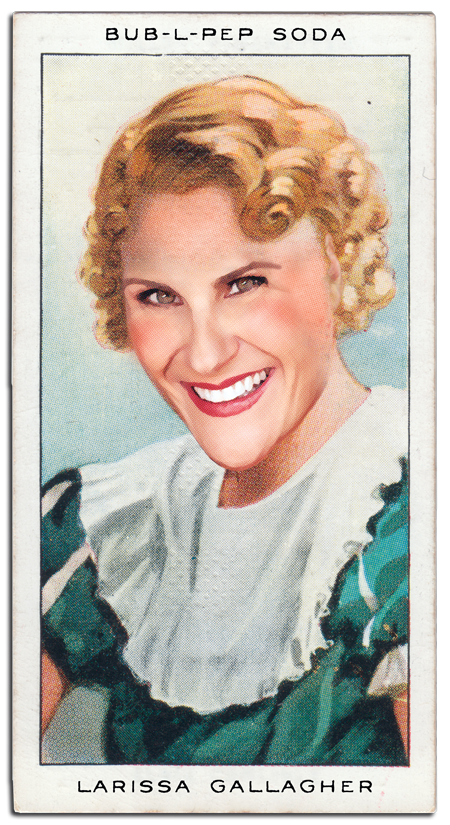 Larissa Gallagher
Voice Actor
Larissa Gallagher
Voice Actor
Larissa is an accomplished voice actor with over 80 credits across animation, anime, audiobooks and video games. Known for her versatility and dynamic range, she draws on her training as a classically trained actor and musical theatre professional. Her standout roles include Steven Universe, OK K.O.!, Monster High, Fire Emblem Heroes, and Street Fighter 6. She recently took on a leadership role at Ethovox, a B2B Voice AI company, ensuring that actor consent, control, and fair pay remain central to the future of tech. Because Voice AI should elevate, not eliminate, the artists who power it.
MON: Penny O'Brien
TBS: Antanasia
TJA: Barbarella Bucci
TIM: Rachel, Mrs. Dowdswell
PC: Nancy Cunard
BRS: Dierdre Wallace
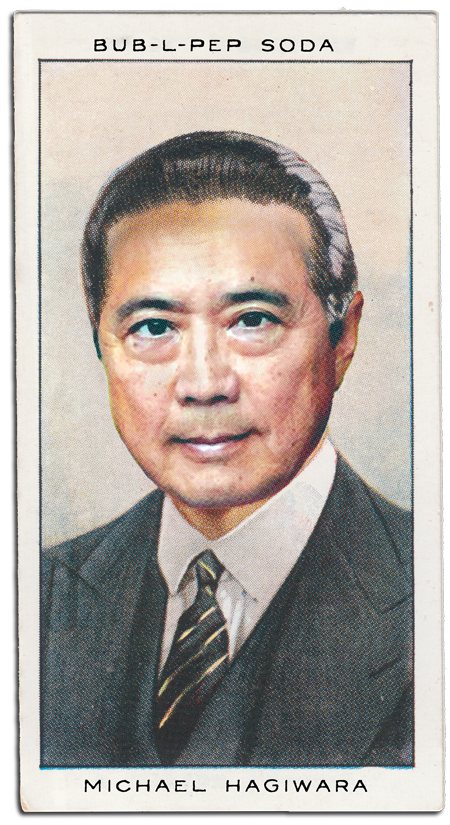 Michael Hagiwara
Voice Actor
Michael Hagiwara
Voice Actor
A veteran performer, Michael received much of his theatrical training and experience from the nationally recognized, highly esteemed East West Players in Los Angeles, California where he was honored with the Founders Award for his dedication to the theatre.
BOB: Lang Fu
MON: Anthony Chang, Mu Hsien
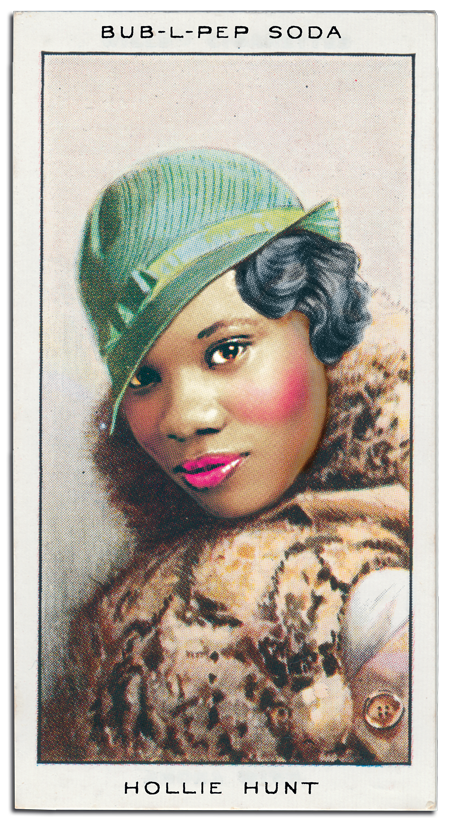 Hollie Hunt
Voice Actor
Hollie Hunt
Voice Actor
After appearing on stage with Theatre Banshee, Hollie joined the DART ensemble.
TWT: Sarafine Glapion
TOD: Asenath Waite
RIW: Hannah
MON: Millie Adams, M'Weru
TSH: Delilah
PC: Sallie Compton
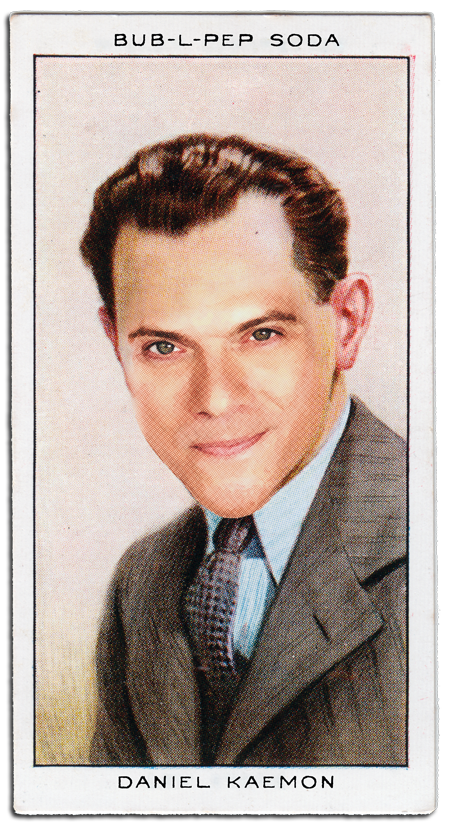 Daniel Kaemon
Voice Actor
Daniel Kaemon
Voice Actor
A Chicago native, Daniel appeared as Mr. Noyes in the HPLHS film of "The Whisperer in Darkness". He is also known for numerous television roles including on Hawaii Five-0, Scorpion, The Orville, The Rookie: Feds, NCIS: Los Angeles, Quantum Leap, Beverly Hills Cop: Axel F. and Matlock.
BOB: Edward Chandler
TPL: Schmidt, Reginald Fessenden
BRS: Bouncer, Jack Dragna
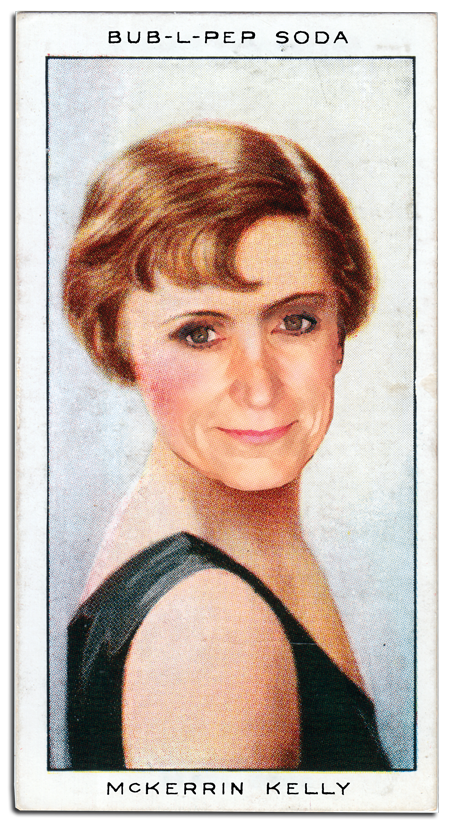 McKerrin Kelly
Voice Actor
McKerrin Kelly
Voice Actor
McKerrin played the Australian museum clerk in the HPLHS motion picture of The Call of Cthulhu. Her name was inadverently omitted from the final audio credits of "The Dunwich Horror", for which we still feel deep regret.
TDH: Lavinia Whateley
SOOT: Mrs. Fife
SOI: Librarian
BOB: Phyllis, et al.
MON: Aunt Berenice, Janice Wycroft, Natalie Smythe-Forbes
COY: Patricia Barrow, Emma Jean
HIM: Eleanor Patterson
TSH: Bonnie, Mercy Dexter
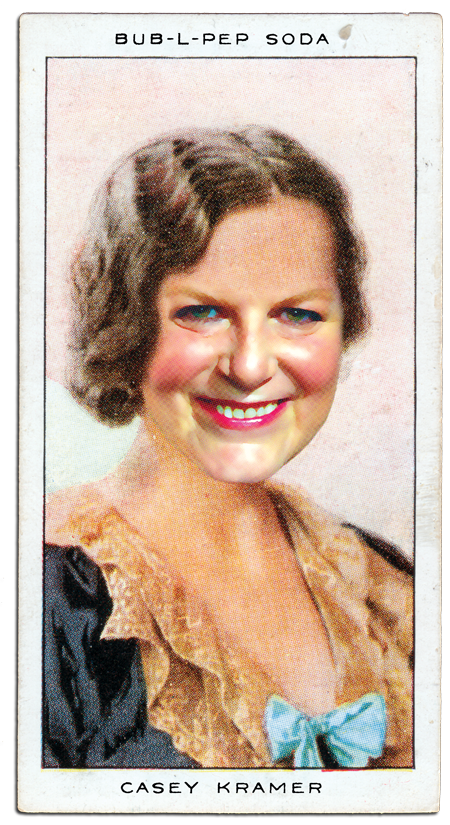 Casey Kramer
Voice Actor
Casey Kramer
Voice Actor
Casey can be seen hanging out with Charles Fort in The Whisperer in Darkness. She often played women in need of lawyers, guns or money. Casey passed away on Christmas Eve, 2023. She will be sorely missed.
TDH: Mrs. Corey
MON: Agatha Broadmoor
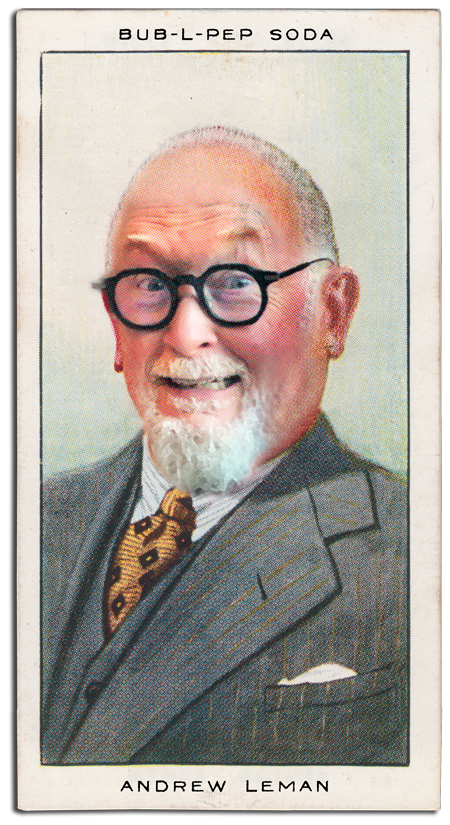 Andrew Leman
Writer/Producer
Andrew Leman
Writer/ProducerVoice Actor
Andrew is a co-founder of the HPLHS and co-writes and produces every episode of Dark Adventure. You can also hear his voice as a frequent reader for the H. P. Lovecraft Literary Podcast/Strange Studies of Strange Stories and Cadabra Records.
ATMOM: Nathan Reed
TDH: Earl Sawyer
SOOT: Nathaniel Peaslee
SOI: Nathan Reed, Joe Sargent
COC: Thurston
CDW: Mr. Ward
COOS: E. Lapham Peabody
DWH: Walter Gilman
HWR: Herbert West
IWP: Nathaniel Ward
HRH: Maurice VanBrunt
DWOW: Nathan Reed
ASC: The Outsider
TWT: Lt. Surplus
TOD: Daniel Upton
BOB: Nathaniel Ward
HOD: Fr. Bardazzi
RIW: Sir William Brinton
FCMV: Dr. Dunham
BAM: Edwin, Dr. Dunham, Dr. Hull
MON: Cecil Watson, Nails Nelson, et al.
TLF: Nick Callum
MAS: Smith, Mevana, Crawford Tillinghast
WID: Albert Wilmarth
COY: Dr. McNeill
HIM: Alan Carrey, Cameron
TBS: Kasimir Bartok
TSH: Dr. Elihu Whipple
TJA: Johnston-Lavis, Shiek Darius
TIM: Nathaniel Ward
TPL: William Beebe
PC: Nathaniel Ward
BRS: Dicky Wheeler, Tahra Bey
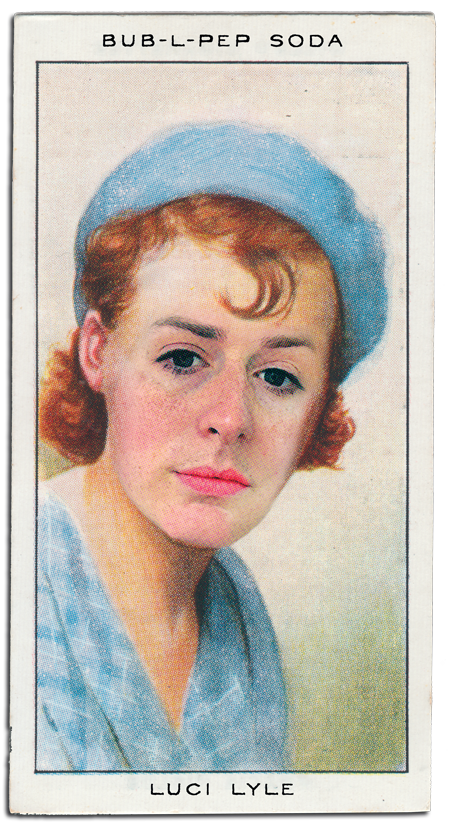 Luci Lyle
Voice Actor
Luci Lyle
Voice Actor
Luci also appears as the young Walter Gilman in the music video for "No Turning Back" from Dreams in the Witch House: A Lovecraftian Rock Opera. She also served a term as the HPLHS Shipping Shoggoth.
DWH: Angry Neighbor
IWP: Rodrigo
HRH: Jimmy the Snitch
DWOW: Ensign Isaza
ASC: Providence Boy
TWT: Claude
TOD: Eddy Upton
BOB: Ted
HOD: Robert Blake
RIW: Alfred Delapore, Miller
FCMV/BAM: Lionel
MON: Maclean, Billee, Mark O'Brien, et al.
TLF: Mikee Munnee, Bernt Martense
MAS: Dr. Talbot, Batta
WID: Boston Station Agent
COY: Newt Stillman, Declan O'Toole
PC: Telegram Boy
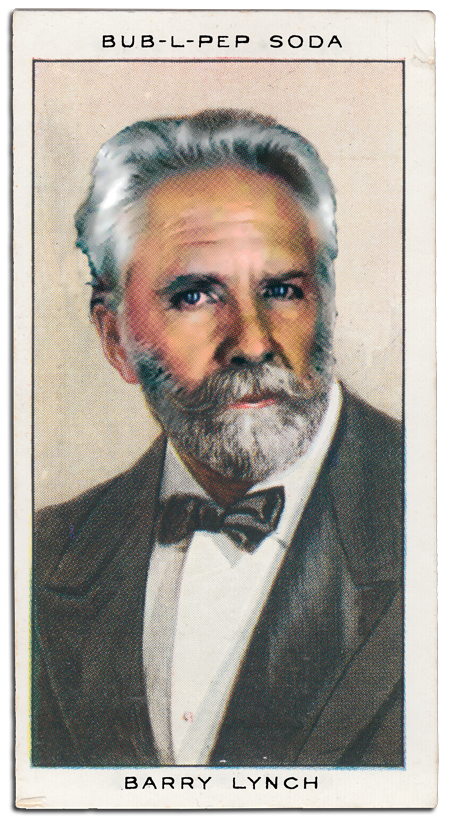 Barry Lynch
Voice Actor
Barry Lynch
Voice Actor
With his additional appearances in the motion pictures A Shoggoth on the Roof, The Call of Cthulhu and The Whisperer in Darkness, Barry has played several icons of Lovecraftian fiction, in addition to a number of Romulans in the Star Trek universe.
ATMOM: Pabodie
TDH: Henry Armitage
SOOT: Creighton, Ashley
SOI: Zadok Allen
COC: Sgt. Hale
CDW: Dr. Willett
COOS: Ammi Pierce
HWR: Hiram Taft
DWH: Henry Armitage, Mazurewicz
IWP: Reis al Drogman
HRH: Robert Suydam
DWOW: Admiral Brookstone
ASC: Mason Farley
TWT: Sgt. Blair
TOD: Reginald Derby
BOB: Kasimir Bartok
HOD: Morris Herald, Mayor Doyle, Bartender
RIW: Grandpa Delapore, Wilfred Crane
BAM: Dr. Watkins, Ambrose
MON: Capt. Robson, Mickey Mahoney, Capt. Montgomery
COY: Tom Rigby
HIM: Kelso
TBS: Zoltan Bartok
PC: Henry Armitage, Goodman Goone
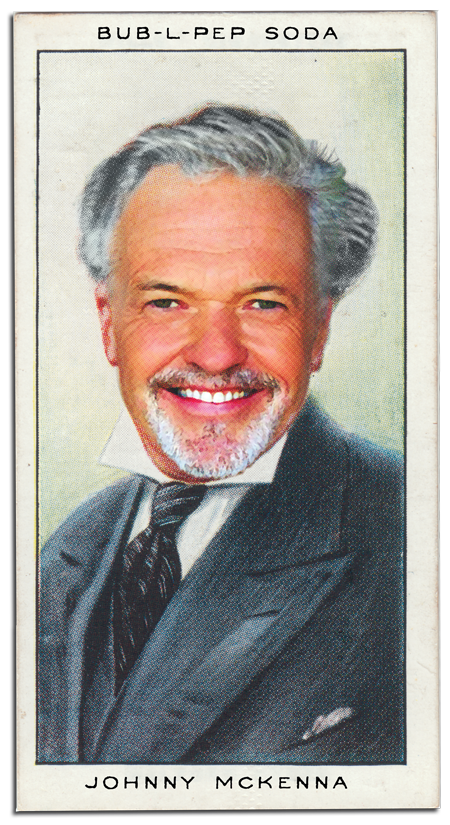 Johnny McKenna
Voice Actor
Johnny McKenna
Voice Actor
You might recognize Johnny's voice from commercials for the Sleep Number bed. He also sings on The Curious Sea Shanties of Innsmouth, Mass.
SOOT: Professor Boyle
SOI: E. Lapham Peabody
BAM: Repairman Johnny, Dr. Turnbull
MON: Mason, Arthur Emerson, Dr. Turnbull, Lars Torvak, Larry D, Street Vendor
TLF: Marvin Munnee
MAS: Obediah, Harper, Juror #2, Walter McComb
COY: Seamus O'Toole
TPL: Captain Waldron, Traube
BRS: Bosco, Prof. Daniel Pratt
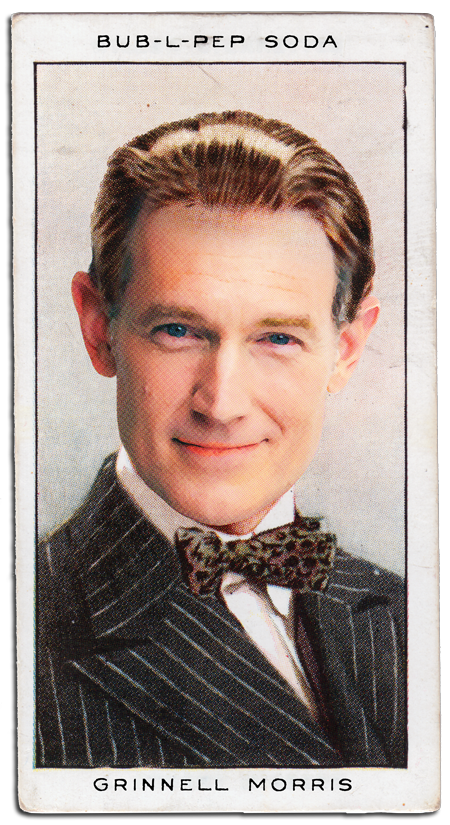 Grinnell Morris
Voice Actor
Grinnell Morris
Voice Actor
DWOW: Radioman Dalager
ASC: Harrison Thurber
TWT: Gerry Morpain
TOD: Chesuncook Marshal
BOB: Jurgens
HOD: Clayton Munn
RIW: Neville Thornton
MON: Lt. Poole, Cassidy, et al.
TLF: Arthur Munroe, Jan Martense, Dad
COY: Roger Kimball
TPL: Boatswain, Withers
BRS: Egon Pierce
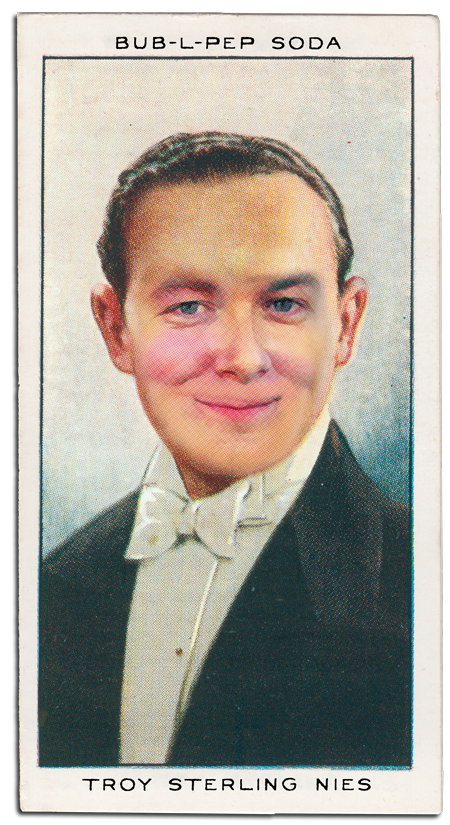 Troy Sterling Nies
Composer
Troy Sterling Nies
ComposerVoice Actor
Troy has composed amazing music for the HPLHS motion pictures The Call of Cthulhu and The Whisperer in Darkness, as well as An Even Scarier Solstice. He has played music at live performances of Dark Adventure in Providence and Portland. When not composing music, Troy saves lives as a physician's assistant in North Dakota.
ATMOM: Original Music, Williams
TDH: Original Music
SOOT: Original Music
SOI: Original Music
COC: Original Music
COOS: Original Music
DWH: Original Music
IWP: Original Music
HRH: Original Music
ASC: Original Music
TWT: Original Music
TOD: Original Music
BOB: Original Music
RIW: Original Music
MON: Original Music
TLF: Original Music
COY: Original Music
TBS: Original Music
TSH: Original Music
TJA: Original Music
TPL: Original Music
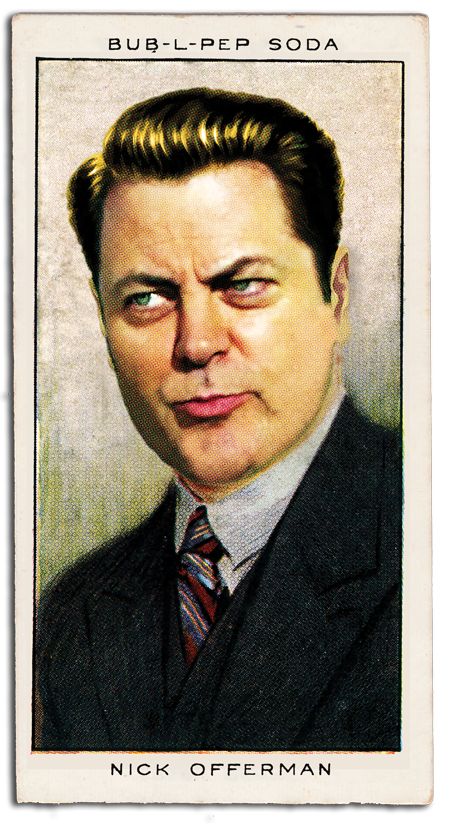 Nick Offerman
Voice Actor
Nick Offerman
Voice Actor
Perhaps most famous for his role as Ron Swanson on Parks & Recreation, Nick is an actor, author, humorist, proprietor of a charismatic woodshop, and proud husband and dishwasher to the world’s most powerful woman – Megan Mullally. Less well known, he played Cthulhu Lives! with Andrew Leman and the gang back in Illinois during college years, and has been a friend of the HPLHS ever since. Numerous scenes of the HPLHS movie The Call of Cthulhu were filmed in Nick's woodshop in Los Angeles.
TWT: Col. Hebért (as Dutch NeoSmith)
PC: Calvin Kirklee
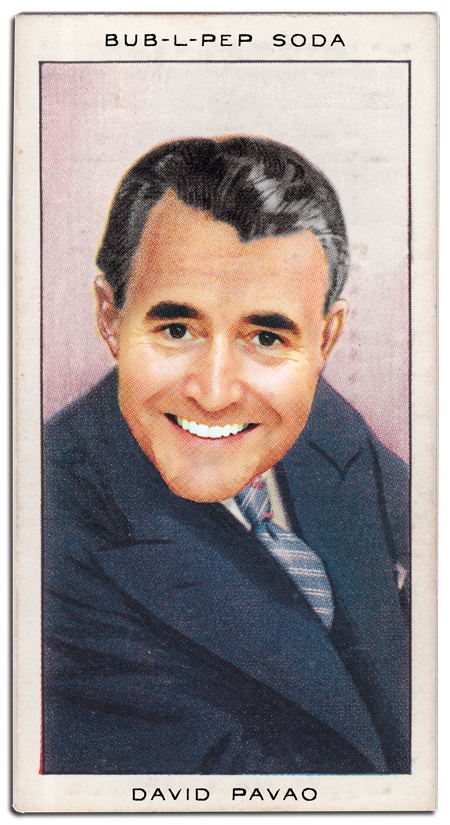 David Pavao
Voice Actor
David Pavao
Voice Actor
David appears in the HPLHS motion pictures The Call of Cthulhu and The Whisperer in Darkness. A long-time presence in the Los Angeles theatre scene, David has also written two solo shows; Adventures In Caregiving and Poster Child: How Charlie’s Angels Kicked My Ass Out Of The Closet. David has studied with The Groundlings, performed stand-up for many years, and acted in productions at The Hollywood Fringe, New York Fringe and Edinburgh Fringe Festivals. David has cult movie status as one of the aliens in Galaxy Quest, “Never give up, never surrender!"
TDH: Silas Bishop
CDW: Revering Manning
COOS: Hughes, Sheriff Clark
HWR: Salamon
DWH: Prof. Upham
TWT: Jabaley
TOD: Chalvers, Dr. Headrick
BOB: Jordan Lowell
HOD: Heath McKerrow, Bishop Harkins
FCMV/BAM: Dr. Fenwick
MON: Carlton Ramsey, Neily Vanderbilt
COY: Mr. Palmer, Max Stillman
HIM: Steven Jones
TIM: Jordan Lowell
BRS: Forrest J. Ackerman
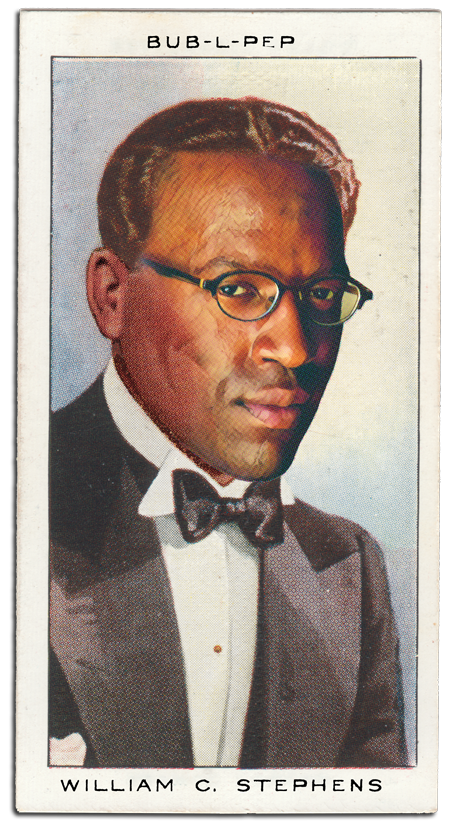 William C. Stephens
Voice Actor
William C. Stephens
Voice Actor
William Christopher Stephens is an Ohio native and graduate of AMDA in NYC. He's appeared in hit films & TV shows such as Marvel Studios' The Avengers and popular TV shows such as FX's The Strain & House. His voice can be heard featured in various video games and most recently as the voice of Jax in Mortal Kombat 11. He is excited to be making his return to the stage and having the opportunity to perform with such a talented cast on Dark Adventure Radio Theatre.
MON: Mukunga, Sam Mariga
TLF: Captain Murray
MAS: Adunga, Dr. Okello
TJA: Ali Ford
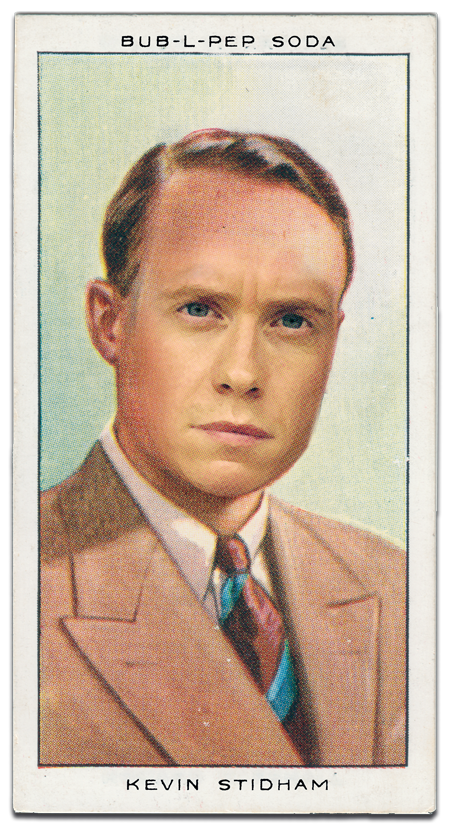 Kevin Stidham
Voice Actor
Kevin Stidham
Voice Actor
Kevin has appeared in numerous Theatre Banshee productions and currently serves as the Shipping Shoggoth of the HPLHS.
COC: Henry Anthony Wilcox
CDW: Charles Dexter Ward
COOS: Stephen Rice, et al.
HWR: Clapham-Lee
HRH: Dr. Peterson, Officer Perkins
ASC: Richard Upton Pickman
TWT: Antoine Lavache
TOD: Edward Pickman Derby
BOB: Baron Hauptman
HOD: Clark Gamwell
RIW: Edward Norrys
FCMV: Martin Gaspee
BAM: Machinist, Eugene Crowley
MON: Marcus Buchannan, Edward Gavigan, Martin Winfield, Nigel, Onkwani
TLF: Trooper Duclair
MAS: Trooper Duclair, Dr. Slauenwite
WID: Mr. Noyes
COY: Walker Davis
HIM: Jennings, Barker
TBS: Felix, Ugor
TSH: Niels, Magistrate, Carrington Harris
TJA: Count Byron Khun de Prorok
TIM: Eustace Miles
TPL: Geoffrey Malins
PC: Providence Mather, Herman the Emergency Broadcaster
BRS: Jack Parsons
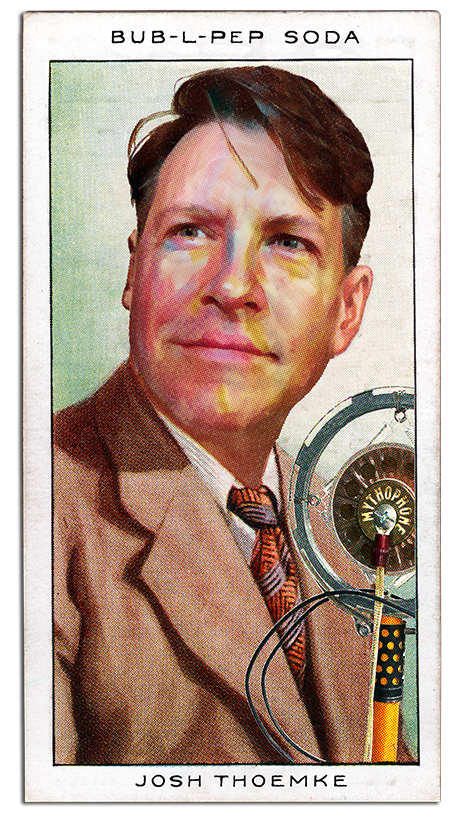 Josh Thoemke
Voice Actor
Josh Thoemke
Voice Actor
Josh has served as the Announcer for every single episode of Dark Adventure Radio Theatre, but only in "Purgatory Chasm" did that character finally get a name. His rich singing voice also appears on the Solstice Carol albums, and he served a term as the HPLHS Shipping Shoggoth.
ATMOM: Gedney
TDH: Curtis Whateley
SOOT: Amaroo
MON: Kakakatak
PC: Everett Bellamy
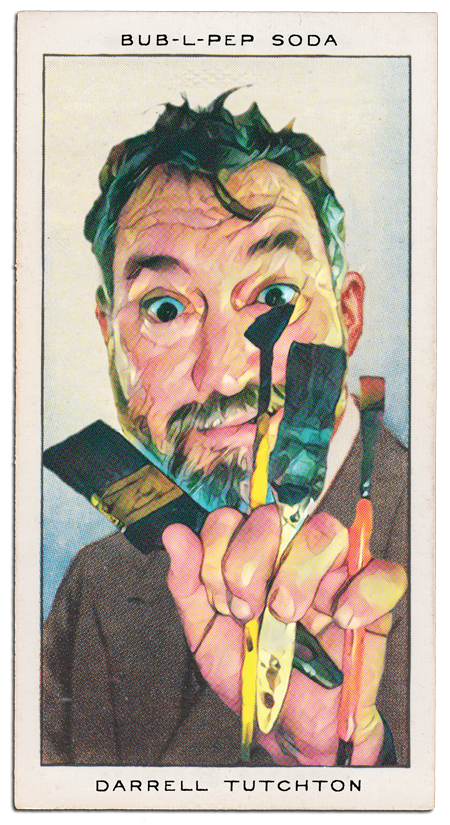 Darrell Tutchton
Illustrator
Darrell Tutchton
Illustrator
Darrell is a co-founder of the HPLHS, and serves as the Society's staff artist. He has done the cover art and incidental illustrations for every episode of Dark Adventure Radio Theatre. He also contributed art for the Codex Beltran-Escavy, as well as t-shirt designs and many other items. He served as a producer on the HPLHS motion picture The Whisperer in Darkness. Darrell is the original Nathaniel Ward, and has stepped up to the microphone in live performances of Dark Adventure in Providence and Portland.
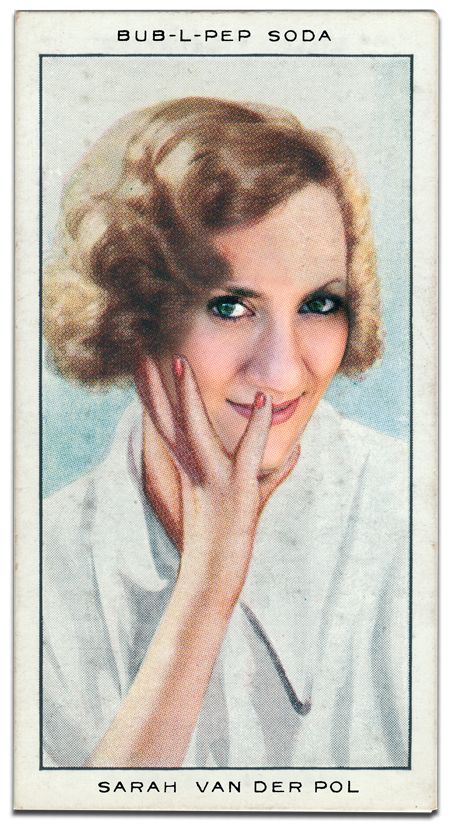 Sarah van der Pol
Voice Actor
Sarah van der Pol
Voice Actor
Sarah was born in The Netherlands and emigrated to the United States at a young age. She holds dual citizenship which has afforded her the opportunity to work in the both the UK and the US. Sarah was trained at the prestigious Mountview Academy of Theatre Arts in London where she received her B.A. in Performance and followed her training with extensive work in the London theatre scene. Some of her UK theatrical credits include August: Osage County at the National Theatre in London, Oleanna at the London Camden People's Theatre and Emma at The Albany. U.S. theatre credits include Abigail in The Crucible and Gwendolyn in The Importance of Being Earnest with the award-winning Theatre Banshee.
COOS: Ruth
HWR: Nurse Ritz
TOD: Darla Kent, Myrtle Crane
BOB: Jenny Alexander
BAM: Sonia
MON: Hazel Claflin
TLF: Tilly, Weduwe
COY: Audrey Davis
TSH: Heather, Georgianne
TIM: Hallie Miles
BRS: Dottie, Jean Harlow
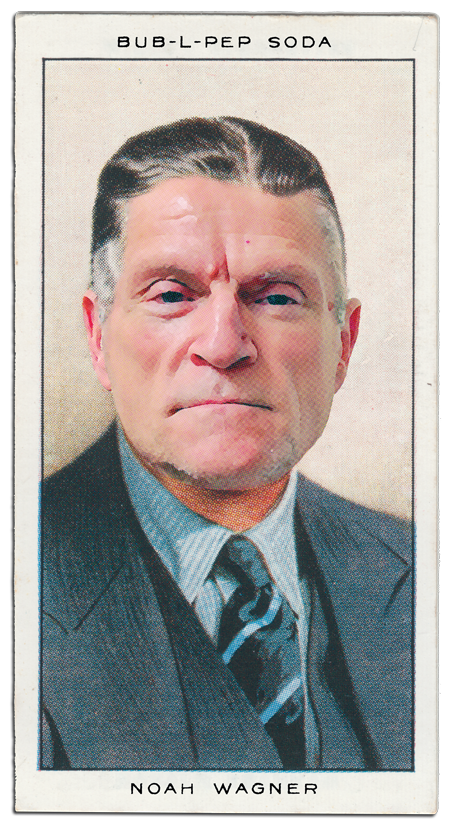 Noah Wagner
Voice Actor
Noah Wagner
Voice Actor
Noah appeared as Captain Collins in the HPLHS motion picture of The Call of Cthulhu, and was the cigarette-smoking host of Dark Adventure Radio Theatre for four episodes.
ATMOM: Chester Langfield
TDH: Chester Langfield, Dr. Houghton
SOOT: Chester Langfield
SOI: Chester Langfield
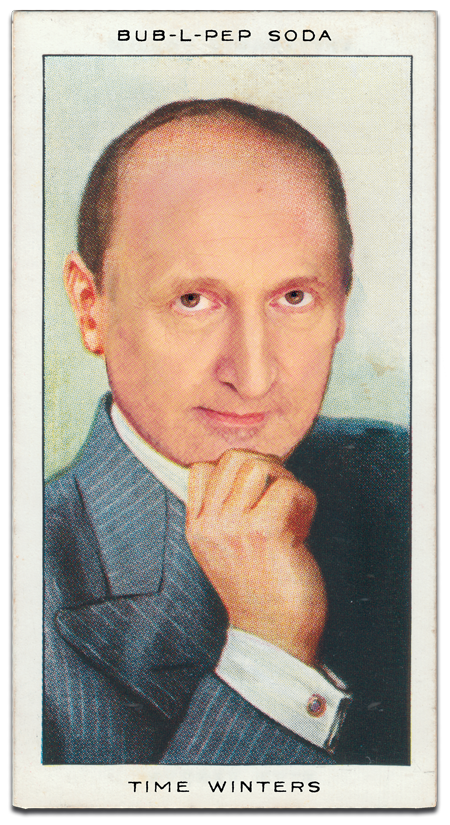 Time Winters
Voice Actor
Time Winters
Voice Actor
After playing a wide variety of characters, Time took on the role of Dark Adventure Radio Theatre host Creighton Cobb.
COC: Professor Angell
CDW: Dr. Waite, Jabez Bowen
COOS: Amos McGregor
HWR: Dr. Allan Halsey
DWH: Fr. Ivanicki, Nathaniel Ward
IWP: Borchardt
HRH: Dr. Lieber
DWOW: Bert Phillips
ASC: Jasper, Joe Minot
TWT: Dugas
TOD: Creighton Cobb
BOB: Creighton Cobb
HOD: Creighton Cobb, Chief Benson
RIW: Creighton Cobb, Edward Thurlow Leeds
FCMV: Creighton Cobb
BAM: Creighton Cobb
MON: Prof. Cowles, Warren Besart, Toddy Randolph, Sir Aubrey Penhew
TLF: Moses Munnee
MAS: Obando, Arnaud Bosch, Nikola Tesla
WID: W.W.N. Anchor
COY: Lafayette Smith
HIM: Complaining Man, Brophy
TBS: Herr Frenzel, Dr. Brunswick
TSH: Doc Hopkins, Goodman Price
TJA: Schöttler
TIM: Mr. Dowdswell
TPL: Collet, Müeller
BRS: Day Player, G. Warren Shufelt
Anatomy of a DART Cover
Creating the cover art and illustrations for Dark Adventure episodes is a collaborative process, involving traditional painting techniques and digital enhancement. To begin, producers Sean Branney and Andrew Leman will bat around ideas with HPLHS artist Darrell Tutchton, discussing what images best encapsulate the story.
For "The Shadow Out of Time", Darrell illustrated the climactic scene in which Peaslee is fleeing from the nightmare Yithian city in the Australian desert. The cover of a CD jewel case is 4.75 inches square, but when you open the folder you get a panorama that is twice as wide as it is high. Working in traditional mixed media, usually ink and watercolor, Darrell does original paintings at a size of 11 x 14, one for each side of the image, that are to be joined digitally by Andrew to create the full panorama.
Shown below is an example of the process of going from original paintings to finished cover art.
Music and Sound Effects
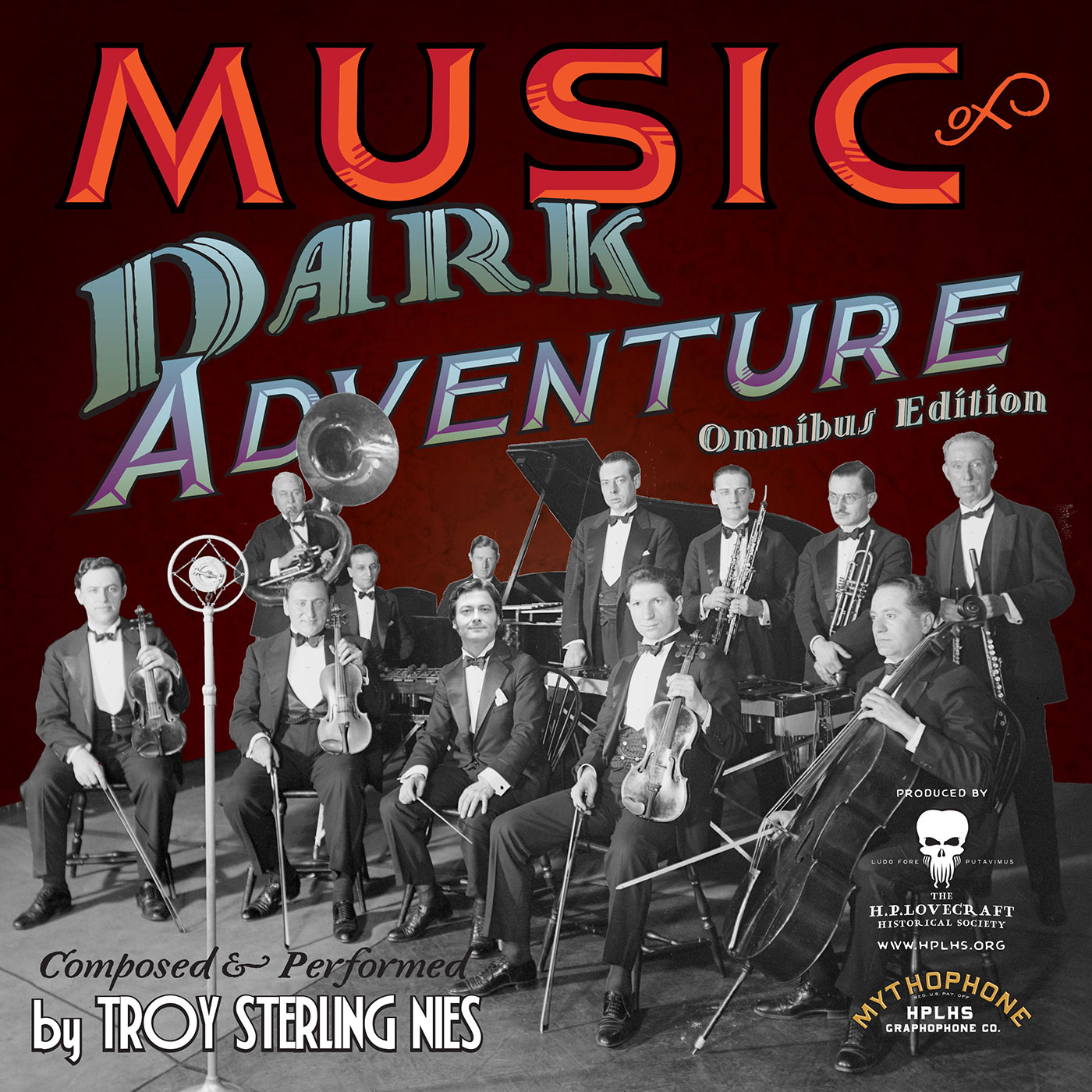 Every episode of Dark Adventure features an original musical score, and it is the heartbeat of the show. We are lucky to have extremely talented composers who are also fervent Lovecraft fans, Troy Sterling Nies and Reber Clark. Troy composed the Dark Adventure theme which begins every episode, but after that every episode features its own musical challenges. Some scores include relatively long atmospheric background music, while others rely more on short transitional cues. Both are crucial to shaping the emotional experience of the show. Composing music takes time, and our artists are often working from a rough and incomplete edit of the episode. They compose music to fit, only to have it cut down or lengthened when the timing of the dialogue is later changed. Although much of the music is performed on virtual instruments, we also record real instruments from time to time. To capture an Australian feel for "The Shadow Out of Time", Troy employed an authentic didgeridoo, which he played himself. For the Miskatonic Fight Song that appears in "Herbert West—Reanimator", Reber Clark prepared chorus parts which were sung separately and then layered together to create a stadium full of rowdy college sports fans.
Every episode of Dark Adventure features an original musical score, and it is the heartbeat of the show. We are lucky to have extremely talented composers who are also fervent Lovecraft fans, Troy Sterling Nies and Reber Clark. Troy composed the Dark Adventure theme which begins every episode, but after that every episode features its own musical challenges. Some scores include relatively long atmospheric background music, while others rely more on short transitional cues. Both are crucial to shaping the emotional experience of the show. Composing music takes time, and our artists are often working from a rough and incomplete edit of the episode. They compose music to fit, only to have it cut down or lengthened when the timing of the dialogue is later changed. Although much of the music is performed on virtual instruments, we also record real instruments from time to time. To capture an Australian feel for "The Shadow Out of Time", Troy employed an authentic didgeridoo, which he played himself. For the Miskatonic Fight Song that appears in "Herbert West—Reanimator", Reber Clark prepared chorus parts which were sung separately and then layered together to create a stadium full of rowdy college sports fans.
Since the music in the show is almost always edited or at least partially obscured by dialogue and sound effects, we are pleased to offer below for your listening pleasure some of the original cues as Troy and Reber wrote them. The HPLHS is also very happy to offer a complete album of music written by Troy. You can find Reber's scores available directly from his own Bandcamp page!
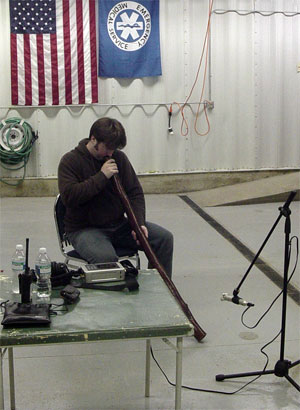
Troy, a former paramedic/EMT, uses his time between ambulance calls experimenting with the didgeridoo for the score of "The Shadow Out of Time".
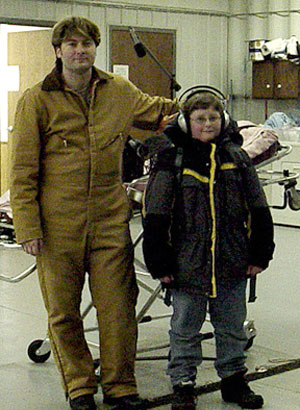
Troy and his son Storm recorded foley footsteps in the ambulance garage in Killdeer, North Dakota.
Sound Effects
The HPLHS has built up an extensive sound effects library over the years, inheriting collections from David Robertson and Kevin McTurk along the way. But even with all these recordings at our disposal, sometimes we have to record custom sound effects for Dark Adventure. Troy and his son Storm trudged through endless North Dakota snowbanks in order to capture sounds for "At the Mountains of Madness". Along the way they heard spooky goings-on at frozen Lake Ilo.
And Sean Branney has been known to buy roasted chickens from the local grocery store, then hang a microphone over them and tear them to pieces in order to capture the sound of mangled/reanimated corpses....
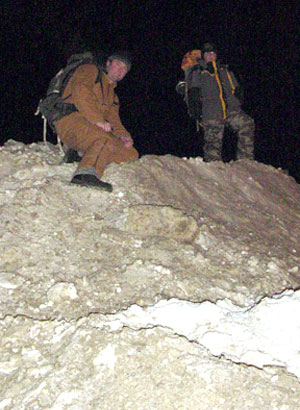
In the unending quest for audio realism and authenticity, Troy and Storm brave the North Dakota winter to capture the sound of intrepid men trudging through snow for "At the Mountains of Madness"
The Production Process: Pre-Production
Writing
Adapting Lovecraft dramatically is a tricky deal; many of his stories are have great dramatic potential, but as HPL wrote them they're not well suited to formats like movies and radio plays. We always endeavor to keep as much Lovecraft as we can in our Lovecraftian adaptations. If we get too far away from Howard, we'll lose the quality about that writing that attracts fans in the first place.
To bring drama to a Lovecraft story often involves the process of externalizing. Many of HPL's stories are about characters going through intense mental events. Often documents, letters, and diaries play an important part in the story, but listeners don't want to hear a guy reading his mail or writing his will; they want stories where thing happen. So, we take liberties with some of the stories to make things as active and dramatic as we can. For example, in the script for "The Shadow Over Innsmouth" we have Olmstead (the narrator) being intereviewed by a federal agent who is pursuing an agenda of his own that becomes clear over the course of the episode.
We add characters as needed and often bring to life scenes which might be only referred to in passing in the story. For example in "The Shadow Out of Time" Peaslee describes his family as being frightened of his post-amnesia personality. We wrote scenes wherein the family actually talks with Peaslee as he's waking up. We experience it with them rather than just having him tell us what happened.
Last, we have to work within the confines of the form. Most classic radio dramas of the 1920s and '30s were 30 minutes to an hour in length. We allow ourselves to go a little longer, but a CD only holds about 80 minutes of audio, so most episodes are between 70 and 80 minutes. Because a page of script equates to about a minute of the show, most scripts are under 80 pages.
Re-writing
So once somebody coughs up a first draft of a script (often Branney) he turns it over to the other guy (often Leman) to have a go at it. The second writer will bring ideas of his own, clarify the murky, cut the extraneous, and overall do his best to make the script better. We'll pass a script back and forth a couple of times and usually by the 4th or 5th draft we have something of the right length that we both think will make a good show.
Auditions & Casting
We're very privileged to count a large number of professional Los Angeles actors among our friends. Sean and his wife Leslie run Theatre Banshee, a small professional theatre in Burbank, California. As a result we regularly cross paths with many very talented actors who work regularly in film, television and on stage. And both Leman and Branney are classically trained actors with MFAs in theatre. But to get the right cast and to give everyone a chance, we usually hold auditions. We regularly bring in new people because, (a) someone we meet might be just right for a role (not just anyone can be Wilbur Whateley) or (b) because a role requires something beyond the grasp of our usual gang. Once we figure out who we want, we call them up and ask them if they want the job.
The Bub-L-Pep Jingle
Unlike other DART music, the tune for Bub-L-Pep was written by Andrew Leman, then orchestrated and substantially improved by Harald Lindell and his wife Kathleen Demarest. Here is some behind the scenes clips of that process. First Andrew sings the basic tune. Next you hear what Hal and Kathy, real musicians, did with it.
The Production Process: Production & Post
Recording Dialogue
Dark Adventure Radio Theatre has been recorded in a variety of studios. The first two episodes were recorded in the dressing rooms of The Banshee theatre in Burbank. Several episodes were recorded at the Cactus Tree Motel studio in Venice, CA, and engineered by our good friend Chris Horvath of Jamnation Music. More recent episodes have been recorded at the Jungle Room recording studio in Burbank, and engineered by Julian Beeston. Announcer Josh Thoemke records all of his lines in Utah, where he lives.
In order to make the most efficient use of studio time and actor availability, we try to record multiple episodes at the same time. That leads to strange recording sessions in which actors switch between parts and record scenes from different shows completely out of order. It can be rather confusing for cast and crew alike.
Editing
Once all the dialogue is recorded, the arduous process of editing begins. For most episodes we've got roughly six hours of recordings, chopped up into hundreds of pieces comprising about 4.5Gb of audio files. The first pass through it all is what we call the assembly edit. We take the recordings, find the best performances and put them into the right order.
Sound Effects
Once the show has been assembled into the right sequence and all the best takes have been selected, we go back through the show to add in sound effects. We select them from our own libraries, record them ourselves, or license them from online sources. As we insert the sound effects, we also clean up the edits, set the levels of volume on the different tracks, adjust the panning (what sounds come in the right and left stereo channels). We also use the computer to create different acoustic spaces (e.g. a lecture hall or a ship's radio room).
It's All in the Timing
A replicated CD needs to be 78 minutes or less for reliable replication. As we finalize the edit with music and sound effects, mixing and dynamics, we sometimes discover that the show is just too long. When every pause that can be shortened or eliminated has been handled, then comes the tough decisions about cutting lines or even whole scenes from the show in order to make sure the finished show can fit on a disc. Although it can be painful, the show is always better for it.
Audio Complete
So once we get all of the pieces together, we mix the show and test it out on a bunch of different speaker systems (cars, ipods, households, theater speakers, etc...). We do a little last minute tweaking and finally proclaim it done. Then we take the final pure audio and apply the Mythophone effect to it. That gives the show a tinny old-time-radio quality at the beginning and the end; we lessen the effect during the middle of the show so it sounds good. Once that's done, we finally output the audio, burn a master CD and send the CD and the cover art off to our replication facility. They'll make a glass master and press our CDs for us and print the artwork on the disc surface.
Assembling
When the CDs come back from the replicator and all the printed pieces are in hand, it's time to stuff jewel cases. Because the prop inserts come in a variety of nonstandard shapes and sizes, some with torn edges and special folds and seals, each jewel case must be stuffed by hand. The Shipping Shoggoths laboriously prepare each prop insert and assemble each package, risking both sanity and carpal tunnels. Each jewel case is sealed and then shrink wrapped by hand.
